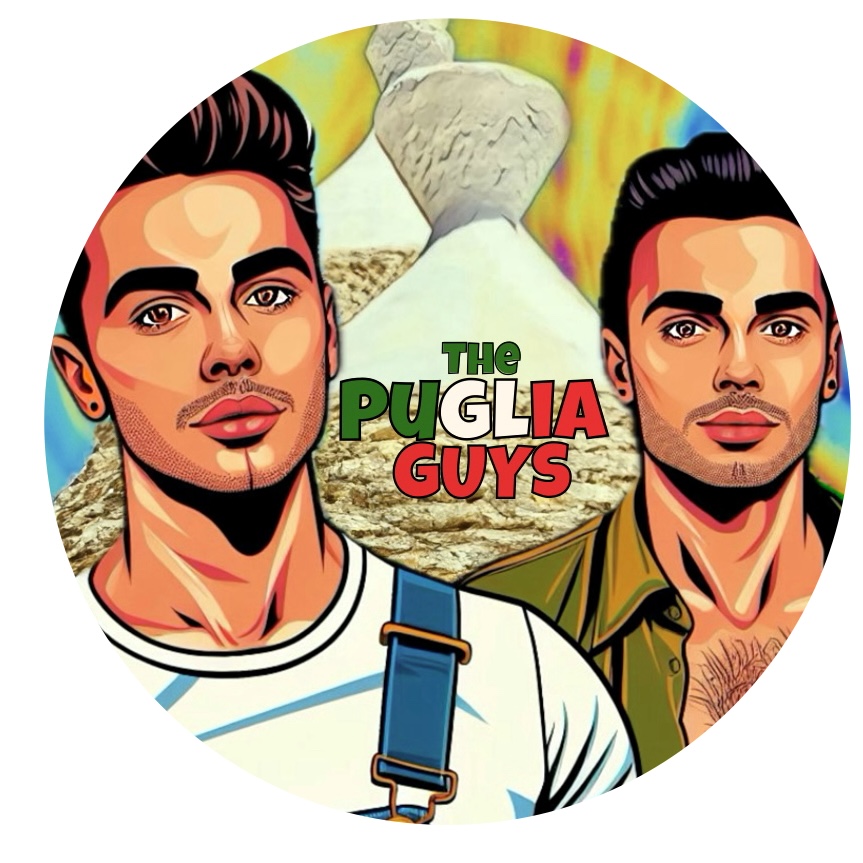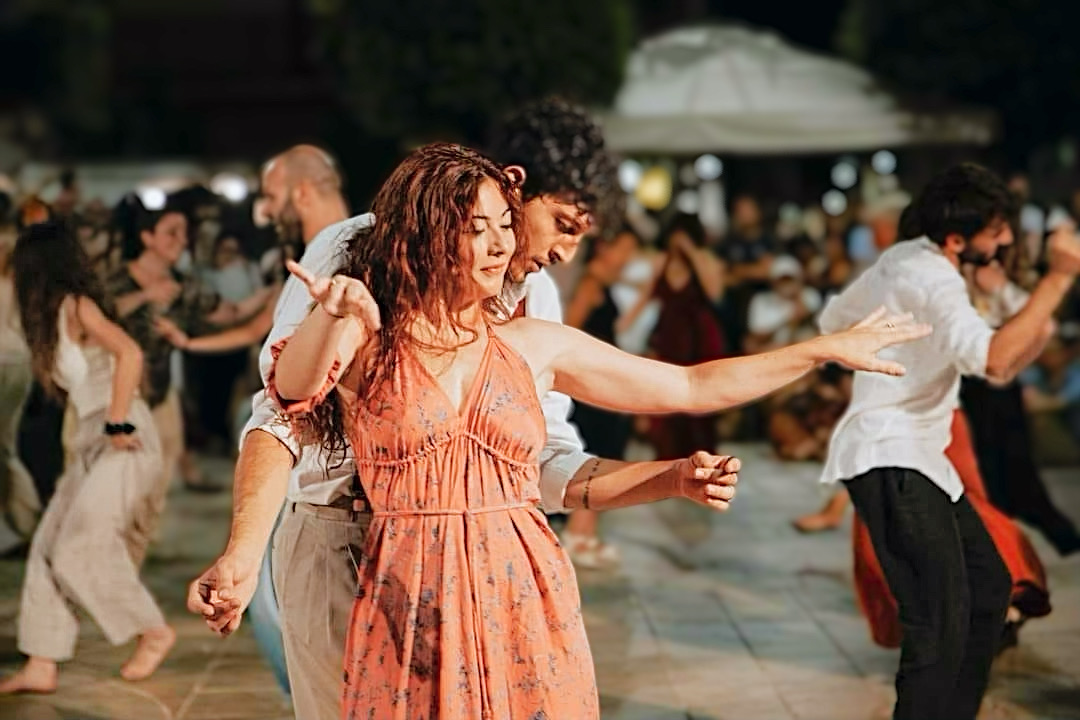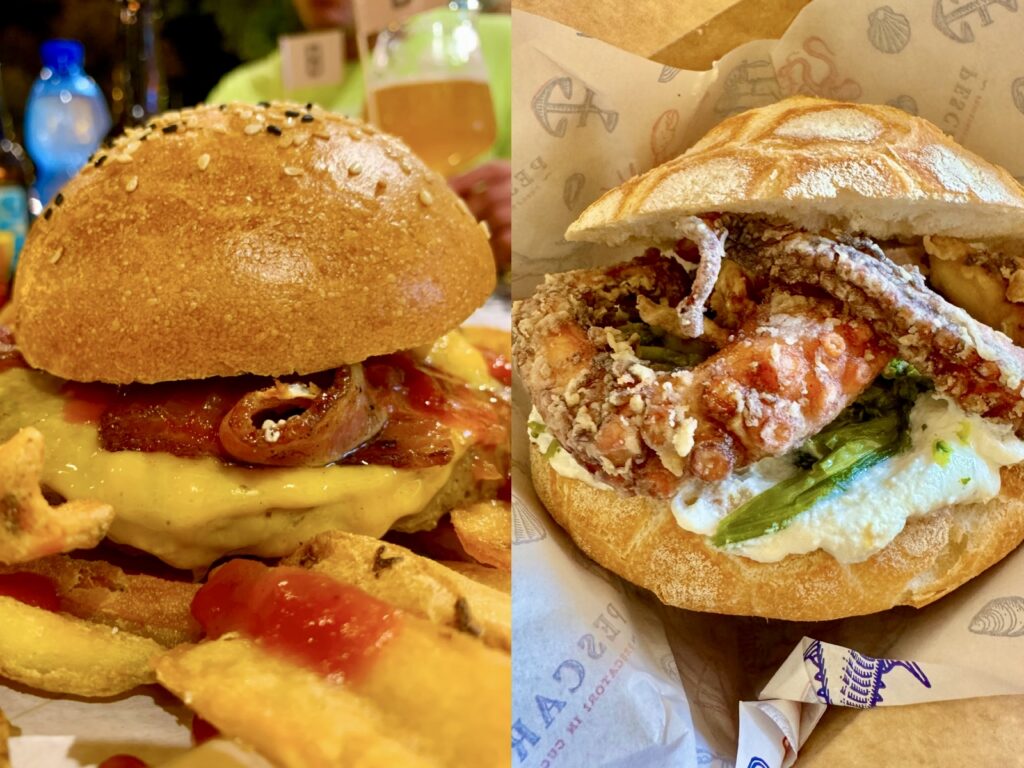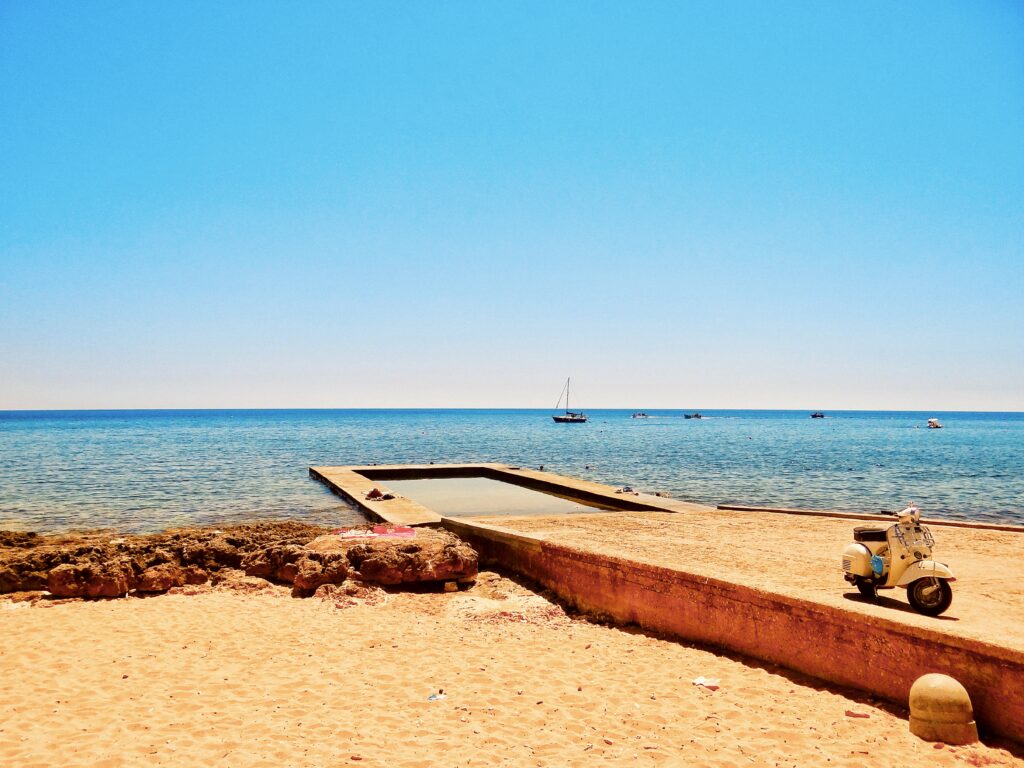Festeggia il festival | Celebrate the Festival!
To experience Puglia through its festivals is to glimpse the soul of the region — a place where faith, fire, food, and folklore come together in profound and unforgettable ways.
Puglia’s sagre festivals, deeply rooted in local culture, are lively celebrations of regional food traditions. These events, held annually, showcase everything from grilled octopus to artisanal cheeses, seasonal vegetables, and local wines. All year round, towns and villages across the region come alive with these festivals, offering visitors a unique opportunity to savour Puglia’s culinary richness, from traditional dishes passed down through generations to new expressions of terroir and taste.
But not all of our festivals are focused on food – though it will usually play a part. Many of Puglia’s most powerful celebrations are spiritual, such as the grand processions of Bari, Bitonto and Fasano, or the Cammino della Madonna del Pozzo in Capurso, where thousands of pilgrims walk through the night to greet the Virgin at sunrise.
Celebrating Puglia’s Patron Saints
Among the most meaningful are the festivals that honour the Patroni di Puglia – the patron saints of our towns and cities. These occasions blend sacred tradition and local pride, often beginning with solemn processions and ending in exuberant feasts, fireworks, or even horse races. In the city of Terlizzi, the Crocifisso di Colonna is towed through town on a 22-metre-high cart pulled by mules; in Turi, the statue of Sant’Oronzo is carried at a run through cheering crowds. Each festival is different, yet all are bound by a common spirit: to remember, to honour, to celebrate.
And then comes Holy Week (La Settimana Santa) a time unlike any other. In towns like Francavilla Fontana, Gallipoli, Molfetta, and Noicattaro, the Passion of Christ is commemorated through silent, torchlit processions, where statues of the Virgin and Christ are carried through the streets by hooded confraternities. The atmosphere is sombre, haunting, and deeply moving — a reflection not of spectacle, but of sorrow, reflection, and profound faith.
All About Communities
These events are not staged for tourists. They are the authentic expression of community identity. For visitors, offering the chance to immerse themselves in local life, to taste dishes born of the land and sea, and to witness traditions that pulse with colour, rhythm, and meaning.
Whether you’re drawn by the spectacle of fireworks in Adelfia, the barefoot processions of Monte Sant’Angelo, the citrus-scented streets of Vico del Gargano, or the heartfelt hospitality of rural towns like San Marzano, Pietramontecorvino, or Grumo Appula, Puglia’s festivals are more than events — they’re invitations.
Invitations to slow down. To join the crowd in the square. To follow the music echoing through narrow alleyways. To raise a glass of Primitivo or Negroamaro. To dance, pray, sing, and savour. Because in Puglia, to celebrate is to belong.
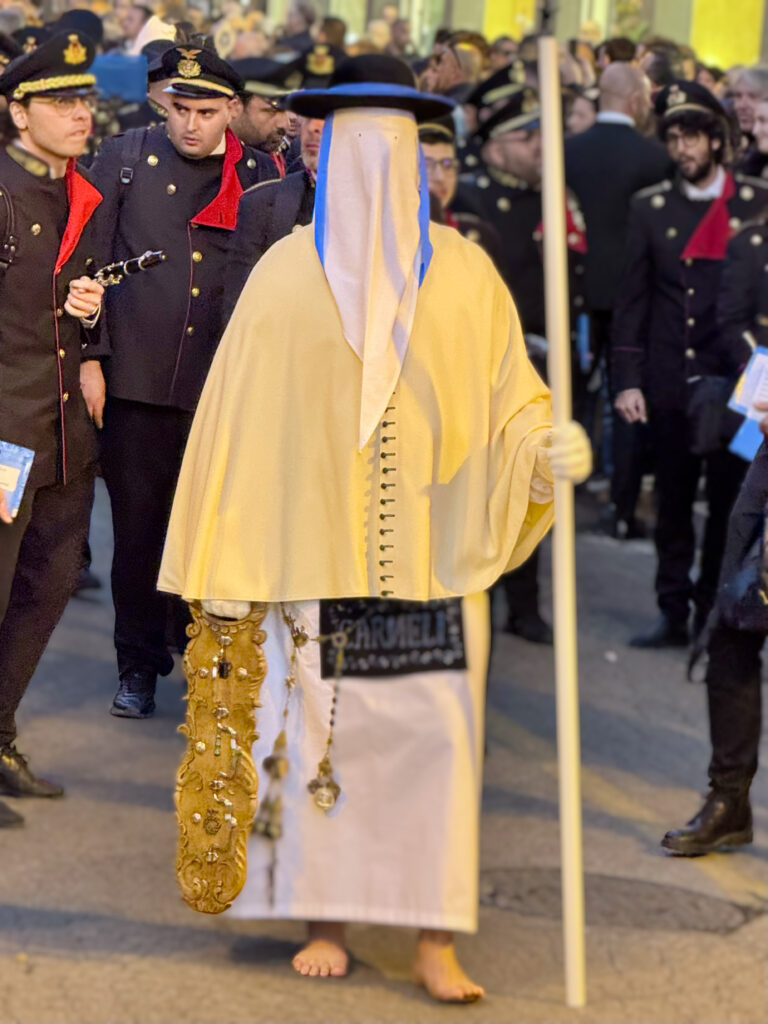
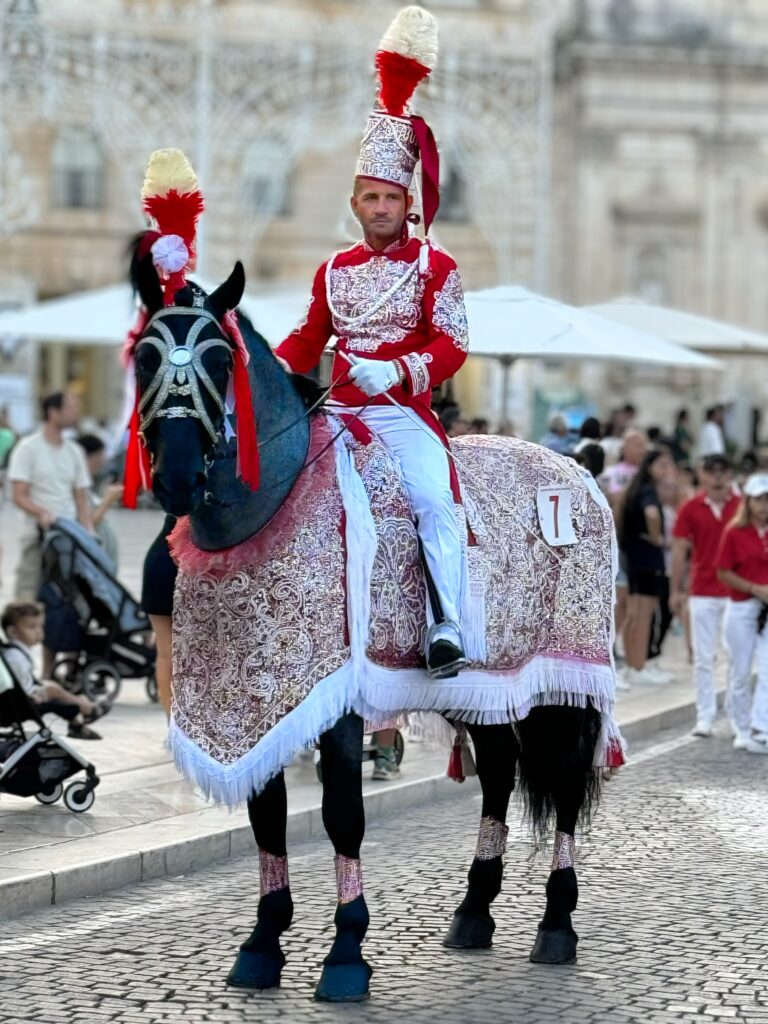
Main Photo Credit: Photo ©️ World Music Academy/Scuola di Pizzica di San Vito | Pizzica festivals organised by World Music Academy / Scuola di Pizzica di San Vito.
Contents
Our approach at Puglia Guys is to let you choose the best base or bases for your vacation in Puglia, according to your own travel style. Using this festival guide, find out which festivals are happening and you can work them into your itinerary, with help from our plan the perfect Puglia itinerary guide. Keep in mind that in Puglia we encourage slow and mindful travel!
- Puglia Festival Calendar
- January | Winter Festivals and Bonfires: Flames of Faith, Ritual and Celebration
- February in Puglia | Carnevale!
- March: San Marzano di San Giuseppe and the Tavolate di San Giuseppe
- April | Primavera and Easter in Puglia
- May | Pilgrimage and Procession (and More Fire)
- Summer Festivals of Light and Flame in Puglia: The Season of Saints, Spectacle and Sound
- June | Popping Puglia’s Cherry Plus Polpo
- July in Puglia | Music Festivals, A Fry-Up and Snails
- Intervallo | The Joy of Puglia’s Sagre Food Festivals
- August in Puglia
- September to November | Autumn in Puglia and Saints of the Harvest
- September Song
- October in Puglia
- November | New Wine, Olive Oil
- December Will Be Magic Again
- Pilgrimage and Sacred Landscapes in Puglia
- Walking the Sacred Mountain: The Gargano Routes
- The Path of the Madonna: Saintly Processions and Devotion from Bari to Capurso
- Walking With Saints | Devotion and Ritual in Grumo Appula, Terlizzi and Turi
- Sea and Spirit: Puglia’s Coastal Devotions
Puglia Festival Calendar
January | Winter Festivals and Bonfires: Flames of Faith, Ritual and Celebration
As winter settles over Puglia, bonfires take away the chill. Across the region, from the limestone hills of the Murge to the shadowed plains of Daunia, Puglia’s darkest nights are lit by winter festivals of fire.
Castellana Grotte and the Notte delle Fanóve
The Notte delle Fanóve on each 11 January transforms Castellana Grotte into a glowing labyrinth. More than 100 bonfires are lit across the town in a tradition dating back to 1691, when townspeople gave thanks to the Madonna della Vetrana for saving them from the plague. According to local legend, on the night of 11 January 1691, two priests kept vigil beneath the altar of the Madonna degli Angeli in the Church of San Francesco d’Assisi. One dreamed that Madonna della Vetrana would save the town; the other, that her sanctuary would become a pilgrimage site.
Using oil from a lamp that burned beside her image, they anointed the sick. Remarkably, the afflicted recovered. The people then burned all items believed to be infected, and from 12 January onwards, no one else died of the plague.
Stalls and homes around each fire offer tastings of taralli, roasted chickpeas and broad beans, olives, focaccine, fried dough, bruschette, grilled meats and seafood, and generous pours of local Primitivo wine. The food is given freely — part of the ritual of hospitality and gratitude that defines the night.
Novoli and the Fòcara
Novoli’s Fòcara di Sant’Antonio Abate, held around 17 January, is the largest bonfire in the Mediterranean. The fòcara is an expression of gratitude, purification, and a celebration of the land and its people.
Built entirely from vine prunings, the fòcara reaches over 20 metres in height, constructed over several weeks. This towering inferno marks the end of a solemn procession in honour of Sant’Antonio Abate, protector of animals and keeper of the flame.
Locals and visitors from across Puglia – and beyond – gather to eat, drink, and celebrate with traditional Salento dishes. Pucce (flatbreads stuffed with olives and onions), pezzetti (meat stewed in spicy tomato sauce), and pittule (fried dough balls), paired with deep red wines and rustic hospitality.
Grottaglie and the Fires of San Ciro
At the end of January, the town of Grottaglie celebrates its patron San Ciro, with two great fires. Known locally as the foc’re, these bonfires are constructed from vine and olive branches.
The first, built in the square dedicated to the saint, is set alight on 30 January, while the second burns the following Sunday near the town hospital. Together, they reflect the saint’s dual role as healer and protector.
Processions wind through the historic ceramic quarter, stalls line the streets with local fare, and the community gathers around the flames. A powerful reminder that even in the coldest month of the year, the warmth of faith and tradition endures.
Other festivals in January include:
Presepe Vivente – Crispiano (TA)
From 26 December to 6 January, the Vallone of Crispiano becomes a living Nativity scene with over 200 costumed participants. The site, rich in natural beauty and monastic history, features historical re-enactments, traditional crafts, and scenes of daily life. Visitors are immersed in an atmospheric setting with artificial snow, torchlight, and zampognari music enhancing the experience.
Presepe Vivente – Mesagne (BR)
The Pro Loco of Mesagne and the Fidas association organise the annual Living Nativity, running from 27 December to 6 January. The procession, featuring characters in period costume, winds through the historic centre and municipal villa, recreating the journey of the Three Kings. The event culminates in adoration at the nativity scene.
Corteo dei Re Magi – Monopoli (BA)
Held on 6 January in the district of Antonelli, this Sacred Representation draws inspiration from the porticoed square of the Mary SS.ma Regina church, built in 1950 after the original St Raffaele church collapsed. The event blends history, commemorating the Epiphany with theatrical scenes and community participation.
Capodanno Bizantino – Oria (BR)
Celebrated on the first Sunday of January, this colourful historical pageant ushers in the new year with medieval costumes, music, flag-waving performances, and processions. Oria’s Byzantine heritage is at the centre of the festivities, which recreate the atmosphere of a courtly new year in southern Italy’s Middle Ages.
Festa dei Falò (Le Fanòve) – Castellana Grotte (BA)
From 8 to 12 January, Castellana Grotte honours the Madonna della Vetrana, credited with saving the town from the plague in 1691. On 11 January, large bonfires called “fanòve” are lit throughout the town to symbolise purification. Celebrations include Holy Mass, folk music, dancing, and traditional food. On 12 January, the icon of the Virgin is carried in solemn procession, followed by a food and wine fair and live concert in Piazza Garibaldi.
Festa di Sant’Antonio Abate e Festa del Fuoco – Novoli (LE)
This spectacular fire festival culminates on 16 January with the lighting of the “fòcara,” a massive bonfire built from over 100,000 vine branches. The event, which attracts thousands of visitors, features religious services, processions, fireworks, traditional food, and live music. Volunteers begin constructing the pyre in early December, with the festival representing a fusion of devotion, rural heritage, and winter celebration.
Carnevale – Massafra (TA)
Kicking off on 17 January with Sant’Antonio Abate and continuing through to Lent, the Carnevale di Massafra is one of Puglia’s most colourful events. It features allegorical papier-mâché floats, masked groups, and signature characters like Gibergallo and Lu Pagghiuse. The festivities end with the funeral procession of the Carnival King. Local food, music, and games make it a lively and inclusive event blending tradition and revelry.
Festa di Sant’Antonio Abate – Gallipoli (LE), Giovinazzo (BA), Latiano (BR), Molfetta (BA), Rutigliano (BA), Arnesano (LE), Biccari (FO) & Racale (LE)
Celebrated on 17 January, the festival includes processions, blessings of animals, fireworks, and communal meals. In Gallipoli, an octave of prayer precedes the main events. Includes torch-lit parades and folk performances.
Mostra del Fischietto – Rutigliano (BA)
Held on 17, 20, and 21 January, this unique fair celebrates Rutigliano’s terracotta whistle-making tradition. The “Concorso Nazionale del Fischietto in Terracotta” showcases the creativity of artisans from across Italy. The town’s streets display oversized “Gallo” whistles as part of the “Galloforie” initiative. Accompanying events include music, food stalls, and guided visits to the Museo del Fischietto in Terracotta.
Festa di San Sebastiano – Gallipoli (LE) & Galatone (LE)
Celebrated around 20 January, this festival honours Saint Sebastian, featuring processions, religious services, traditional music and dancing. In Gallipoli, it is held alongside the festivities for Saint Agatha. Both towns commemorate their patron saint with a rich programme of devotion, historical re-enactments, and fireworks.
Festa di San Ciro – Grottaglie (TA)
On 31 January, Grottaglie pays tribute to San Ciro, co-patron of the town, with a day of religious rites culminating in a barefoot procession through the streets. The focal point is the enormous bonfire known as the “Foc’ra di San Ciro,” constructed from olive wood and vine prunings. Traditional food, fireworks, and folk music form an integral part of the celebrations, which draw pilgrims and visitors alike.
International Hot Air Balloon Festival – Putignano (BA)
Held in early January, this spectacular event sees the skies over Putignano filled with balloons in a variety of shapes and colours. It’s a visual feast for adults and children alike, and a major draw for ballooning enthusiasts from across Italy.
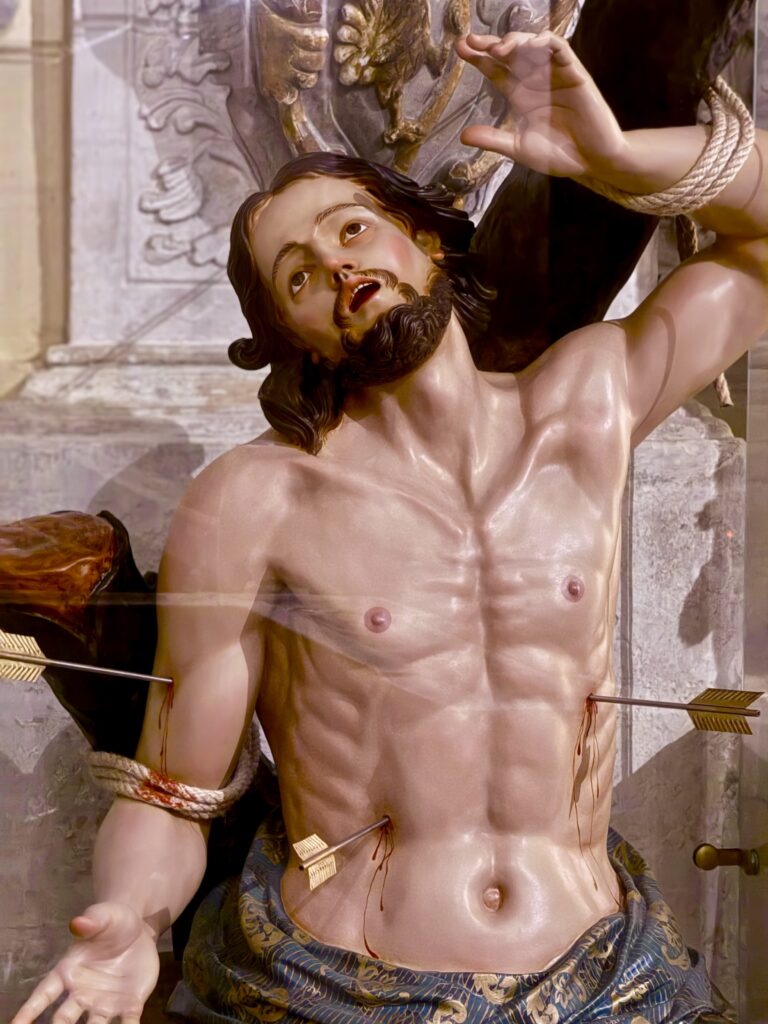
February in Puglia | Carnevale!
Carnival traditions in Italy might last for a day or more than a month. But the climax always comes on Shrove Tuesday with a great feast before the abstinence of Lent (the Italian word Carnevale is thought to come from the Latin carnem levare, meaning ‘take away the meat’).
Until then we eat, drink and celebrate. Children delight in dressing up and throw confetti. Parades take place with floats and oversized papier-mâché models, often mocking real-life politicians or digging deep into Italy’s history and fairy tale traditions.
Carnevale di Putignano – Putignano (BA)
The Venice carnival may be the best known of Italy’s Carnevale. But Putignano in Puglia is home to the oldest and most extended Carnevale celebration in Italy. Festivities begin on December 26 with a feast for Santo Stefano. Almost two months of celebrations take place ending with a final parade and “funeral” for Carnevale when 365 tolls of the Macaroni Bell officially mark the end of revelry.
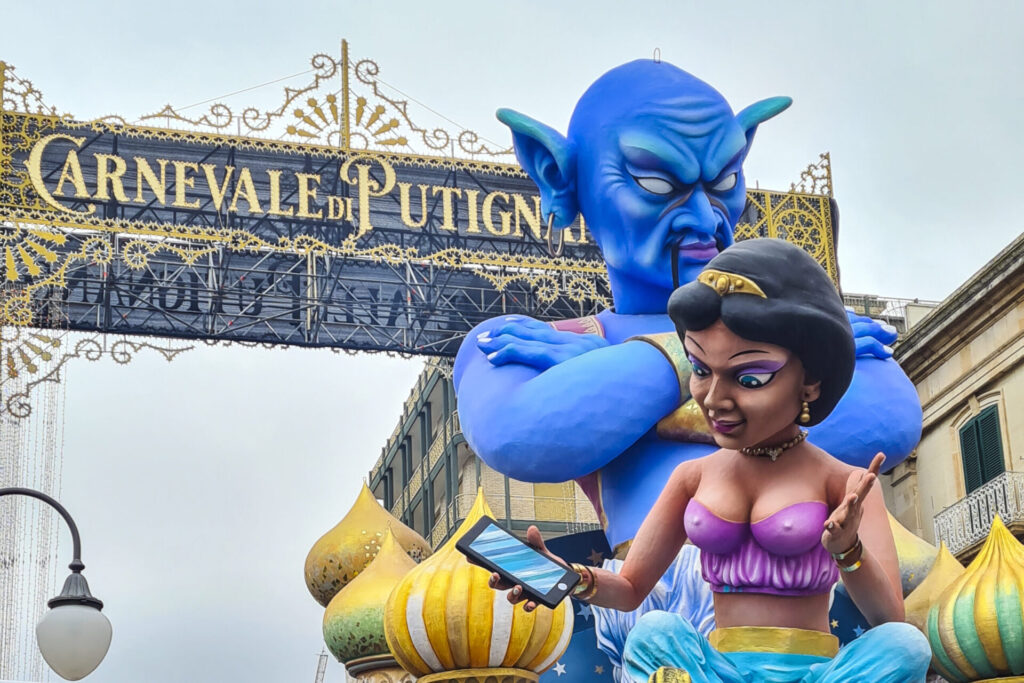
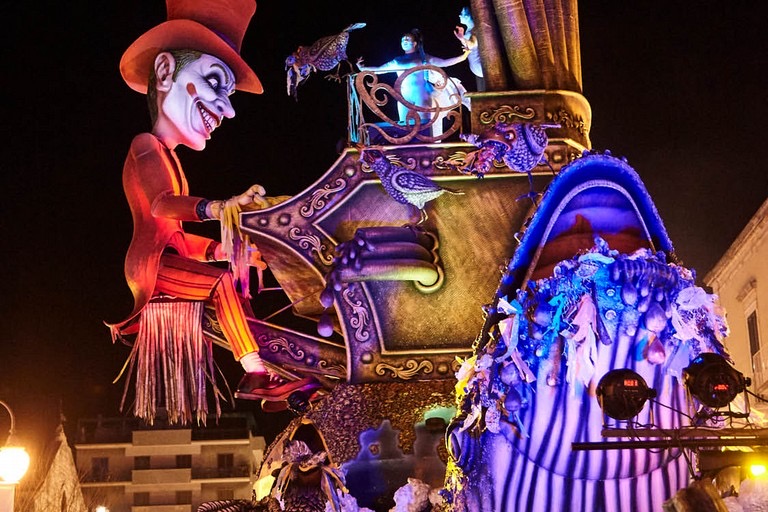
Carnival of Manfredonia – Manfredonia (FG)
A joyful and extravagant carnival featuring colourful floats, costumes, music, and street dancing. The celebration includes the famous Gran Parata delle Meraviglie, with local schools and artists showcasing elaborate creations. It is one of the most spirited Carnivals in Puglia.
Sagra della Mandorla – Ruvo di Puglia (BA)
This almond festival, held on variable dates in February, celebrates one of Puglia’s signature ingredients. The event includes tastings of almond-based sweets and biscuits, cookery demonstrations, and local product stalls.
Festa di San Biagio – Bitonto (BA)
Celebrated on 3 February, this religious event is marked by a solemn procession and the traditional blessing of bread, believed to protect against throat ailments.
Festa di San Biagio – Cisternino (BR)
Also on 3 February in Cisternino, this festival honours Saint Biagio despite the absence of a dedicated church. A blessing of the throat ceremony is held at the Church of San Cataldo, followed by fireworks, musical performances, and community events.
Carnevale della Grecìa Salentina – Martignano (LE)
From 3 to 13 February, the town of Martignano hosts this culturally rich carnival blending local and Grecìa Salentina traditions. Events include costumed parades, allegorical floats, music, and dance performances. Deeply rooted in the area’s Hellenic heritage, the festival celebrates identity, creativity, and local customs in an inclusive and festive environment.
Festa di Sant’Agata – Gioia del Colle (BA)
Held on 5 February, this is one of the town’s most heartfelt religious celebrations, with processions, communal feasts, and fireworks in honour of the saint. The event brings the community together in acts of public devotion.
Carnevale – Palio del Viccio – Palo del Colle (BA)
Taking place from 11 to 13 February, this historic carnival features a mounted tournament dating back to 1477. Riders representing town districts try to pierce a suspended water-filled balloon while standing on horseback. The event includes a solemn “Investitura del Cavaliere,” a Baby Palio for children, a carnival parade, and celebrations highlighting agricultural traditions and local pride.
La Disfida di Barletta – Barletta (BT)
On 13 February, Barletta commemorates the legendary 1503 duel between Italian and French knights, led by Ettore Fieramosca, who defended Italian honour during the Italian Wars. The victory became a national symbol, later immortalised in literature. The annual celebration includes historical re-enactments and cultural events recalling the duel’s patriotic legacy.
Festa di San Valentino – Vico del Gargano (FG)
From 13 to 17 February, the medieval village of Vico del Gargano becomes the “Village of Love,” honouring Saint Valentine as the protector of lovers and citrus groves. Streets and the Chiesa Matrice are adorned with oranges and laurels. Highlights include a lovers’ blessing at the “Well of Promises,” traditional processions, and the “Palio di San Valentino” horse race on nearby San Menaio beach.
Festa di San Gregorio – Nardò (LE)
Held around 19–20 February, this patronal festival commemorates San Gregorio Armeno, protector of Nardò during the 1743 earthquake. A silver statue is paraded through the streets, followed by fireworks. The next day features concerts, cultural performances, and a lively fair in the historic centre, uniting the town in devotion and celebration.
Festa della Pignata – Celenza Valfortore (FG)
Held on 23 February in the town of Celenza Valfortore, this culinary festival celebrates the octopus and the region’s seafood tradition. Food stalls serve various octopus dishes, roasted chickpeas, and traditional sweets. The event is accompanied by live folk music, brass bands, and dancing, creating a lively atmosphere rooted in local gastronomy and community spirit.
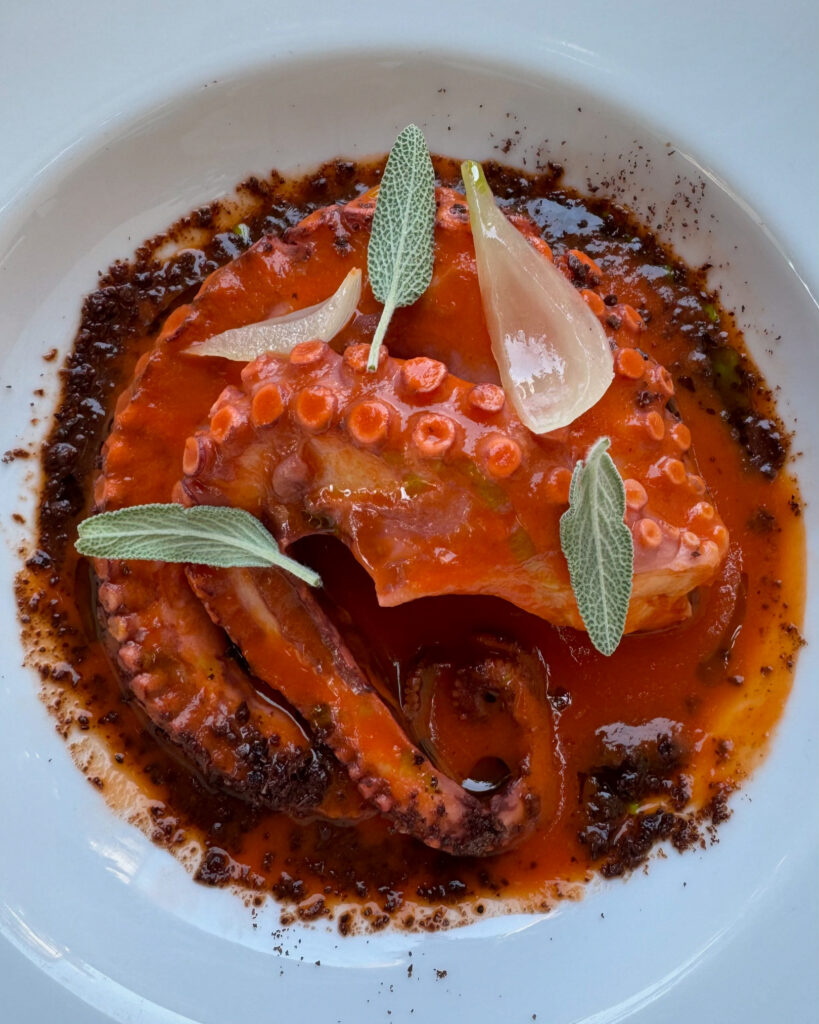
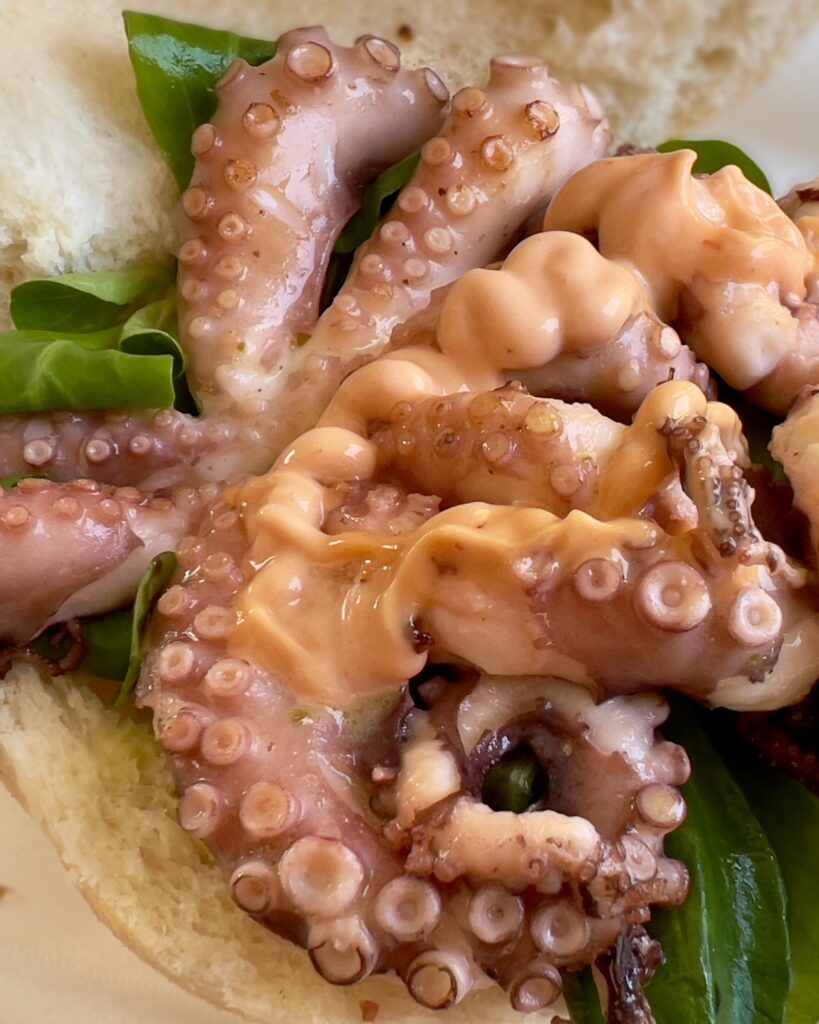
Falò di San Mattia – Deliceto (FG)
On 24 February, Deliceto lights large traditional bonfires to honour San Mattia, credited with ending a plague in the 1600s. Organised by the Comune and the local Pro Loco, the 45th edition of this centuries-old tradition maintains its spiritual and historical importance, marking the town’s gratitude with fire, community gatherings, and celebration.
Fete de lu caiunn – Faeto (FG)
This late-winter culinary festival in Faeto celebrates traditional stews cooked in large cauldrons. The “Festival of the Cauldron” brings the community together with local cuisine, warm fires, and a convivial atmosphere. Though the date varies, it often falls in February and reflects the mountain village’s Franco-Provençal culinary and cultural roots.
March: San Marzano di San Giuseppe and the Tavolate di San Giuseppe
Father’s Day in Italy always falls on la festa di San Giuseppe – St. Joseph’s Day – 19 March. We celebrate with cakes of course. Zeppole di San Giuseppe.
Made using a soft choux pastry, baked and then fried according to the original recipe although you can just bake them. Once cool they are filled with crema pasticciera (crème pâtissière) before being topped with some more of the pastry cream and finished with sour cherries in syrup.
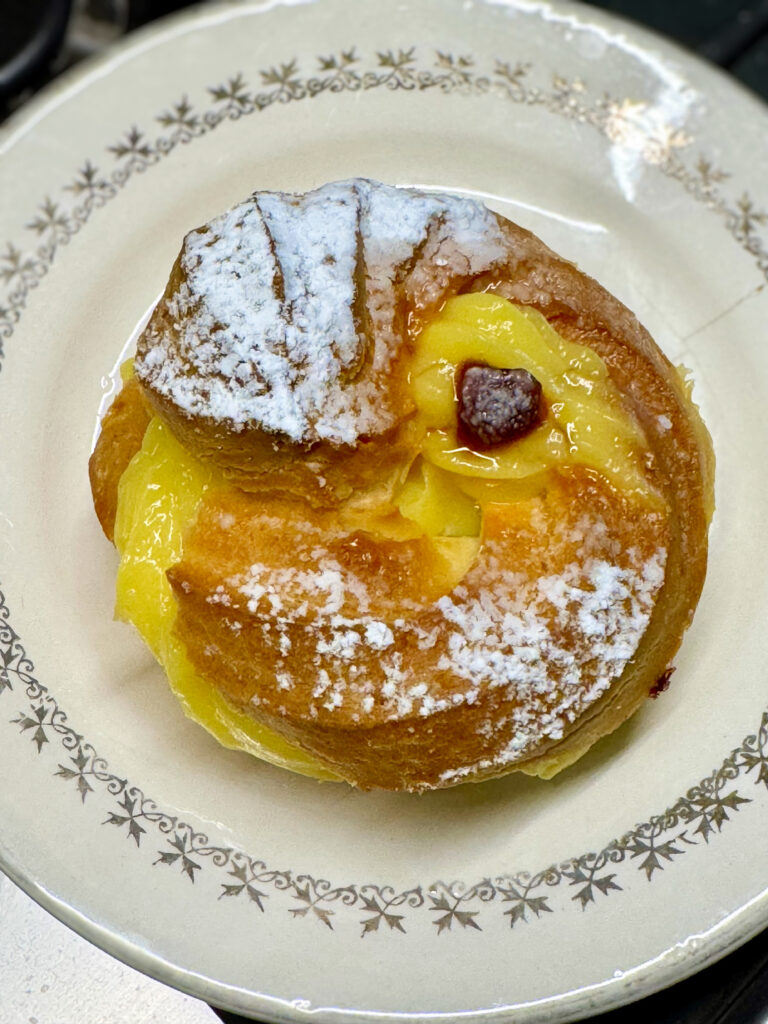
Other celebrations mark the feast of San Giuseppe, including the agricultural village of San Marzano di San Giuseppe. Here one of Italy’s largest Arbëreshë (Italo-Albanian) communities, adds to Puglia’s fire festivals. Each 19 March the town holds a processione della legna — a slow parade of horse-drawn carts loaded with firewood, bound for the main square.
At night, the ziarrij e mate, an enormous bonfire, is lit to honour the saint. The ritual harks back to times when spring droughts threatened harvests, and prayers were answered with fire and feasting.
At the heart of the celebration are the Tavolate di San Giuseppe: communal tables groaning with peasant fare – broad bean purée, chickpea pasta, meatballs, seasonal vegetables, wine, and traditional biscuits – all offered freely to those in attendance. It is an expression of shared faith, generosity and memory.
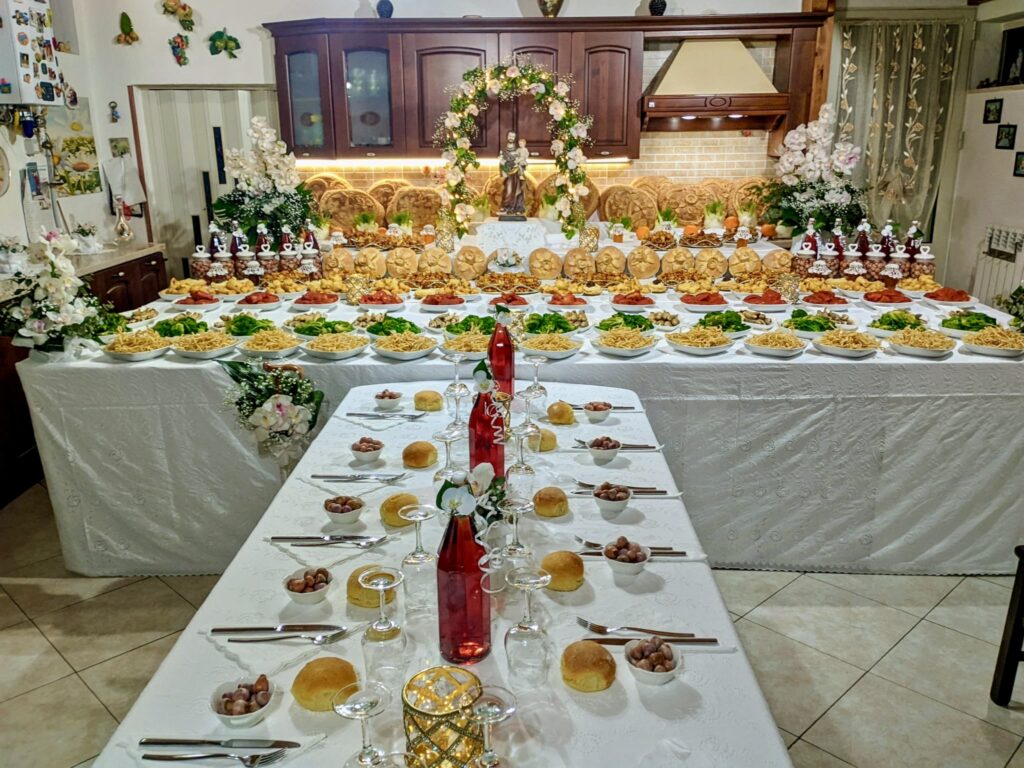
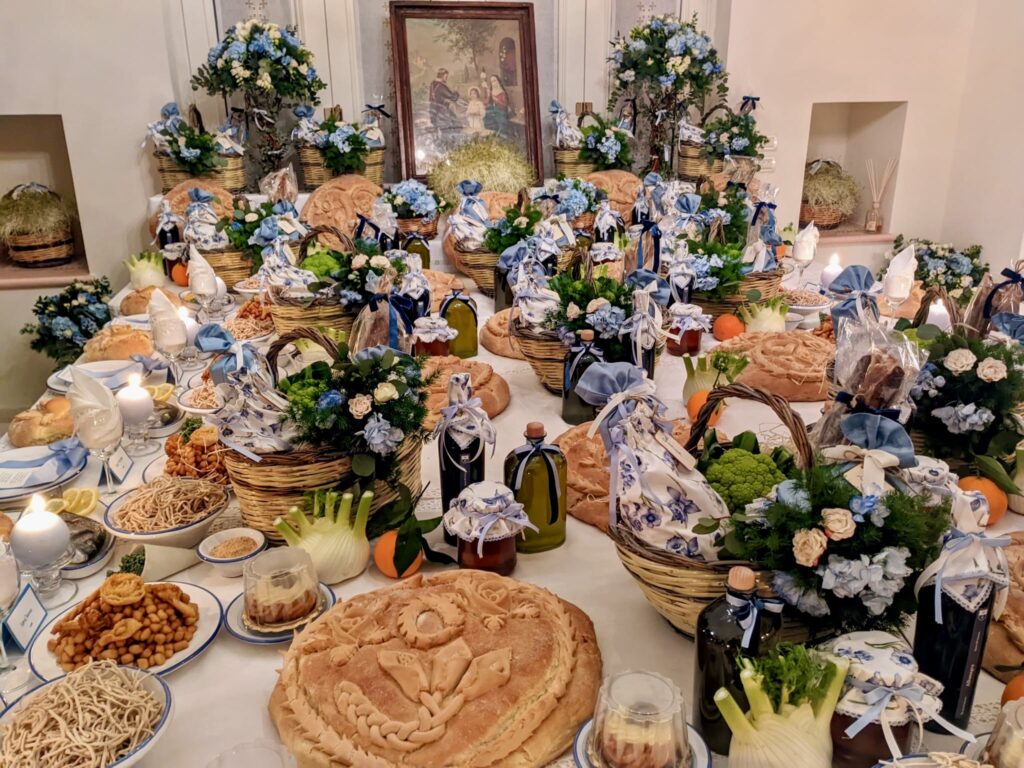
March also marks the transition from winter to spring, and in Puglia that means a mix of food festivals, women’s celebrations, and solemn religious observances leading up to Easter.
Carnival of Putignano – Putignano (BA)
Running from late December to Shrove Tuesday, the Carnival of Putignano is one of Europe’s oldest and most famous carnivals. Its roots lie in medieval rites, beginning with the satirical “Festa delle Propaggini” on 26 December. Each parade features large papier-mâché floats interpreting a seasonal theme—recently, fairy tales. Events unfold across the historic centre, culminating in a grand finale that draws visitors from across Italy and beyond.
Bari International Film Festival (BIFEST) – Bari (BA)
A key cinematic event held each March in Bari. The 2024 edition included premieres and awards, such as the acclaimed “Il mio posto è qui.” The festival promotes Italian and international cinema, celebrating artistic excellence with screenings, panels, and red carpet ceremonies in Bari’s main theatres and cultural venues.
Maria SS.ma di Costantinopoli – Bitritto (BA)
Held around 7 March, this celebration honours the patron saint of Bitritto. Festivities include religious rites, folk events, cultural meetings, and a night-time fireworks display. The event is central to the town’s identity, blending sacred traditions with community festivities.
International Women’s Day – Across Puglia
Celebrated on 8 March throughout the region, especially in Bari and larger cities. Events include exhibitions, talks, and cultural programmes highlighting the contributions of women to Puglian society, history, and arts.
Sagra della Zeppola – Cutrofiano (LE)
Taking place around 19 March, this sagra honours St Joseph by showcasing the “zeppola di San Giuseppe”—a traditional sweet filled with custard or ricotta. Alongside food stands, the event features live music, dance, and local crafts, bringing the community together in a joyful celebration of culinary and cultural heritage.
Fiera della Focaccia – Cisternino (BR)
Around 19 March, this fair celebrates the region’s beloved focaccia with tastings of various traditional forms, from tomato-topped to rosemary and olive versions. Music, street food, and local markets fill the streets of the historic centre.
Festa di San Giuseppe – San Marzano (TA) & San Cassiano (LE)
Celebrated on 19 March, this feast honours Saint Joseph with religious ceremonies and the preparation of “Tavole di San Giuseppe” – lavish altars set with symbolic dishes and traditional foods such as circular loaves and zeppole. The ritual of sharing food expresses community spirit and charity. Processions, food fairs, and musical events round out the celebrations.
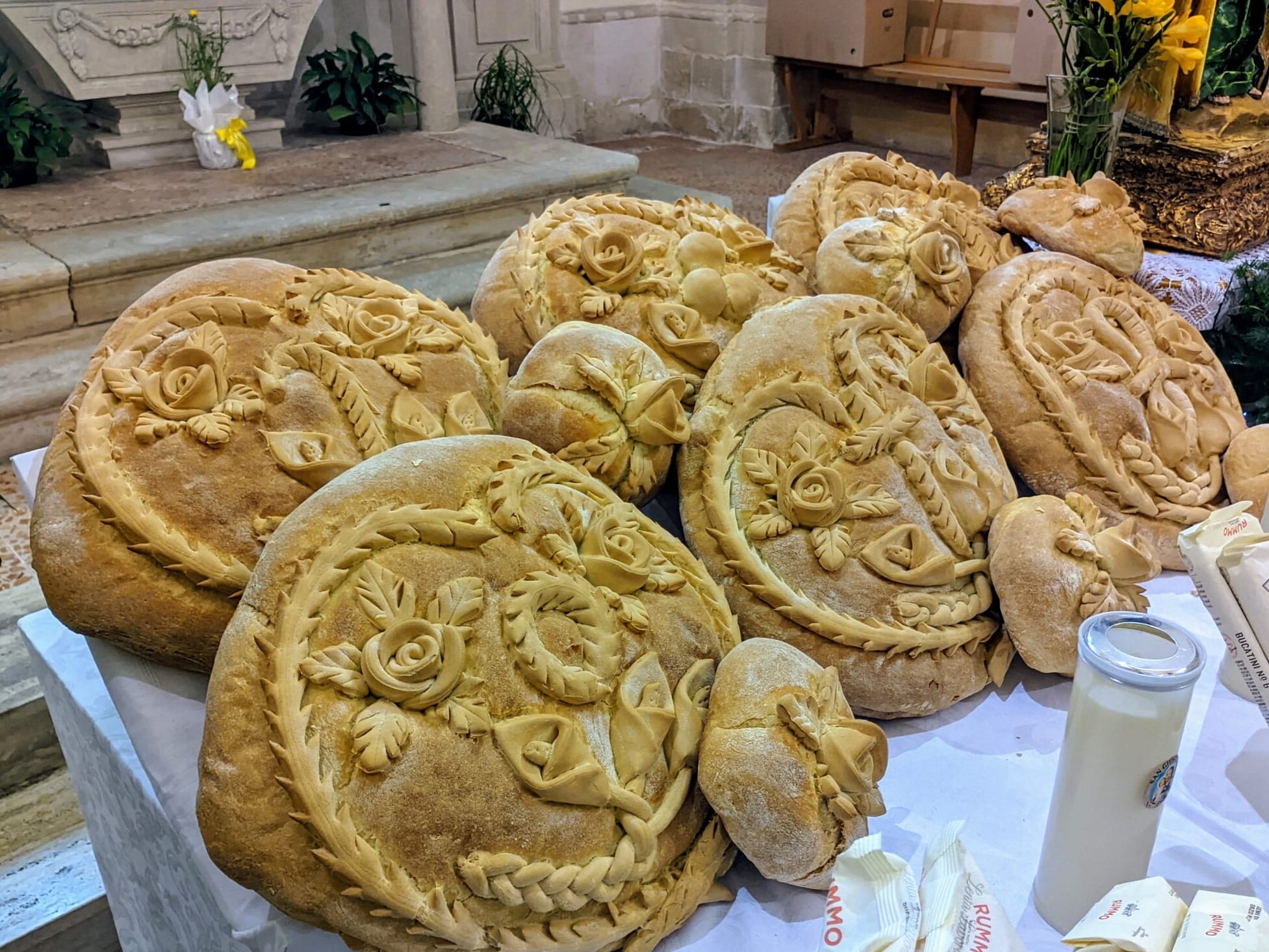
Fiera dei Campanelli – Maglie (LE)
Also known as the Fiera della Madonna Addolorata, this traditional fair takes place around Easter on Viale dell’Addolorata. It features local crafts, agricultural tools, livestock, and artisanal products, combining sacred devotion with agricultural heritage. The event attracts locals and visitors from surrounding towns.
Madonna dei Sette Veli – Foggia (FG)
A major religious procession honouring the Madonna of the Seven Veils, Foggia’s protector. The icon, hidden under seven symbolic veils, is paraded through the city alongside 16 confraternities, civil authorities, and thousands of citizens. The day after, a public holiday, a mass is held in the Cathedral with the Sacro Tavolo dell’Iconavetere displayed on the altar, symbolising deep-rooted devotion.
Settimana delle Croci – Noicattaro (BA)
Part of the “Settimana Santa Nojana,” this series of Holy Week processions takes place from 28 to 30 March. Events include the Crociferi procession on Holy Thursday, the Madonna Addolorata on Friday, and the Processione dei Misteri on Saturday. Organised by the local parish and Augustinian fathers, these rituals reflect centuries of faith and devotion.
Sagra del Carciofo – Cerignola (FG)
Late March sees this sagra dedicated to one of Puglia’s prized vegetables. The event includes traditional recipes, tastings, and cooking demonstrations, all centred around the artichoke at the height of its season.
Primavera Musicale – Trani (BT)
An elegant classical music festival hosted in Trani’s Teatro Comunale. Early March concerts feature chamber music, solo recitals, and orchestral works by international performers in a refined setting.
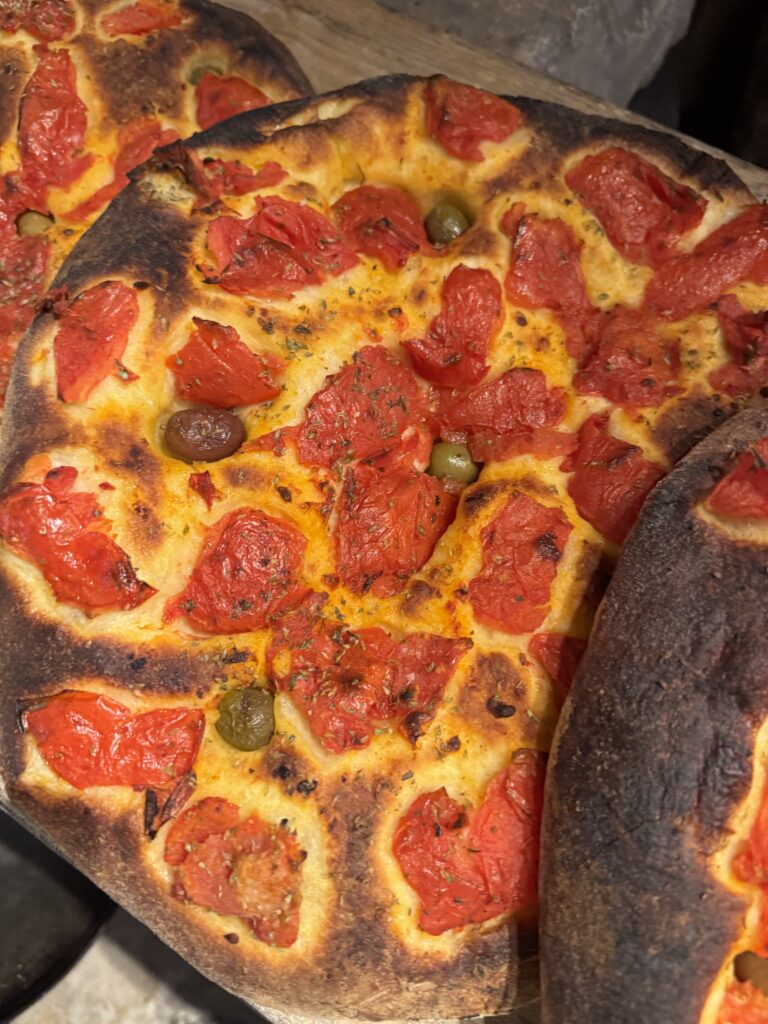
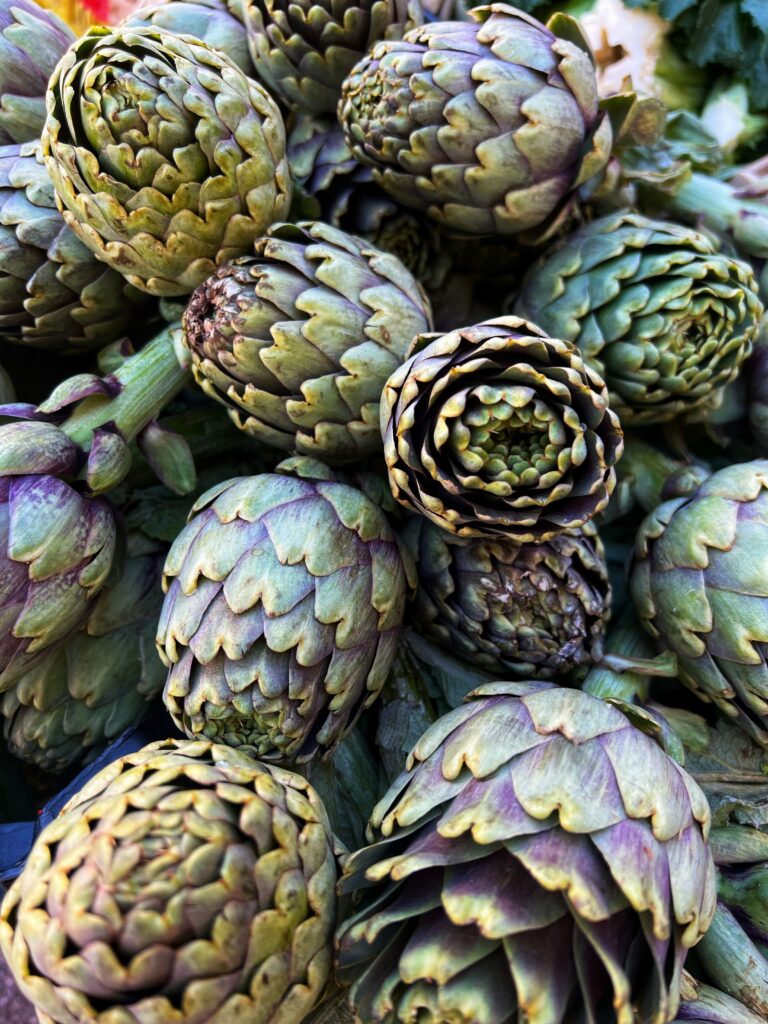
April | Primavera and Easter in Puglia
Puglia commemorates Easter with great solemnity, particularly during Holy Week. Many towns hold elaborate processions and ceremonies to commemorate the Passion and Death of Christ. These rituals are often marked by solemn music, prayers, and the use of symbols and images that evoke feelings of sorrow and mourning.
The penitential rituals, such as self-flagellation, can also contribute to the sense of solemnity and gravity of the occasion. These practices are meant to be a form of devotion and penance. They are a testament to the deep faith and religious commitment of the people of Puglia.
The most famous processions take place in Taranto, Francavilla Fontana and Gallipoli, attracting visitors for their moving rituals and historic traditions.
Read the Puglia Guys Guide to Holy Week in Puglia
The most famous processions take place in Taranto, Francavilla Fontana and Gallipoli, attracting visitors for their moving rituals and historic traditions.
Procession of the Mysteries – Francavilla Fontana (BR)
Held on Good Friday, this dramatic procession features papier-mâché statues depicting scenes from the Passion of Christ, accompanied by barefoot penitents known as Pappamusci. Organised by local confraternities, it begins at the Church of Santa Chiara and proceeds solemnly through the streets with funereal music and devotional chants, embodying Francavilla Fontana’s deep religious traditions.
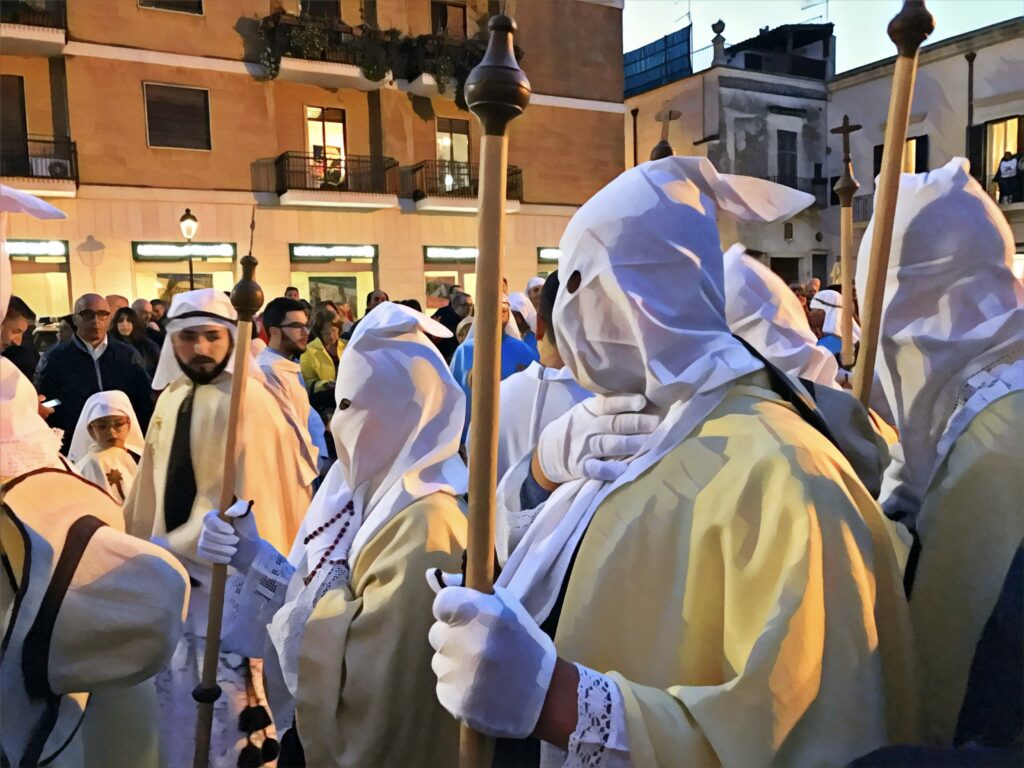
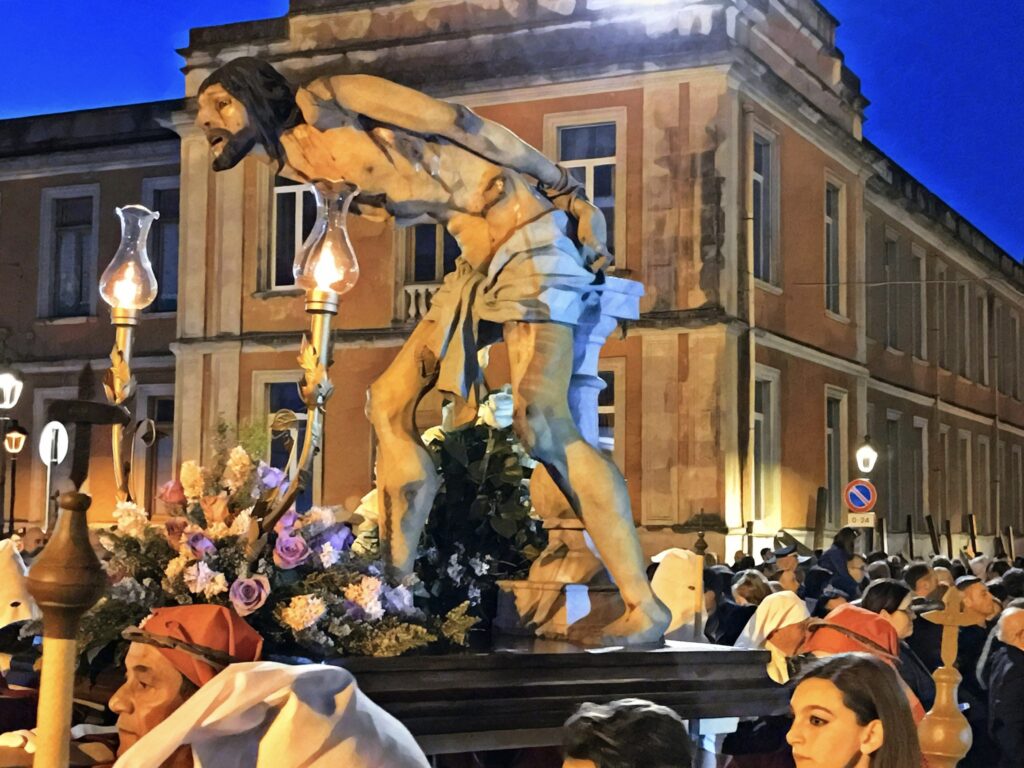
San Marco’s ‘Fracchie’ Procession – San Marco in Lamis (FG)
On Good Friday, enormous wooden torches (fracchie), some as long as 15 metres, are dragged through the streets to light the way for the Madonna Addolorata. Dating back to the 18th century, this unique ritual symbolises the Virgin’s search for Christ and creates a striking visual and spiritual experience, attracting thousands of visitors.
Cuddura Festival – Santa Cesarea Terme (LE)
Celebrated on Easter Monday, this traditional event pays homage to the cuddura, a sweet, ring-shaped bread once given to children. Now replaced by chocolate eggs, the cuddura is still revered in local bakeries. The festival honours the treat’s symbolism of fertility and abundance, offering a nostalgic and delicious glimpse into Salento’s Easter traditions.
Fiera di San Leone – Bitonto (BA)
Held on 6 April across Bitonto’s central streets, this historic fair includes craft stalls, exhibitions, and reenactments. It is accompanied by traffic and public transport modifications and forms part of the city’s spring cultural calendar.
Festa di San Giorgio con Sagra della Frittata – Vieste (FG)
From 14 to 23 April, Vieste honours San Giorgio with religious services, a statue procession, and a unique omelette festival. On 23 April, a giant frittata is cooked and shared in Piazza Santa Maria delle Grazie. Events include a horse race on the beach and end with fireworks and concerts, combining devotion and culinary celebration.
Sagra del Carciofo – Brindisi (BR)
Held in mid-April, this festival celebrates Brindisi’s seasonal artichoke crop. Street food, local music, and cooking demonstrations draw food lovers from across the region.
Sagra dei Tarallucci e Vino – Alberobello (BA)
Held in late April in the heart of Alberobello’s trulli district, this festival celebrates two iconic Puglian products: taralli(savoury biscuits) and local wines such as Primitivo. Street stands offer tastings of sweet and savoury varieties alongside regional delicacies, with live music and a festive atmosphere that celebrates Puglia’s culinary identity.
Festa d’aprile – Castellana Grotte (BA)
Organised by the Comitato Feste Patronali, this multi-day celebration honours Maria Santissima della Vetrana, the town’s patron saint. Events include religious processions, music concerts, fireworks, and hot air balloon launches, creating a colourful spectacle that draws visitors from across the region.
Festa dell’Incoronata – Foggia (FG)
Taking place from 22 to 28 April, this pilgrimage and festival centres on the Basilica della Madonna dell’Incoronata. Celebrations include rosaries, vespers, and the “Cavalcata degli Angeli,” a symbolic procession of children in angel costumes. Thousands attend this deeply spiritual and community-rooted event.
Festa del SS. Crocifisso di Varano – Cagnano Varano (FG)
Celebrated on 23 April, this festival commemorates a miraculous rainfall event over 500 years ago. It features a lake procession on traditional boats, religious ceremonies, and fireworks. The strong faith and folklore surrounding the Crocifisso attract pilgrims and visitors to this lakeside town.
Festa di San Giorgio – Chieuti (FG)
Held on 23 April, this Arbëreshë-rooted celebration honours St George with a village-wide procession, traditional rituals, songs, and symbolic gifts of wine and sweets. The festival reaffirms the town’s unique identity and sense of heritage.
Festa dell’Annunziata – Castro (LE)
From 24 to 26 April, Castro honours Maria SS. Annunziata with processions, luminarie, and fireworks. A highlight is the Sagra del Pesce a Sarsa, featuring bluefish fried and marinated in vinegar. The festival blends religious fervour with culinary tradition, attracting large crowds to this coastal town.
Festa del Passa Passa – Turi (BA)
Held on 25 April, this unique procession linked to the Annunciation involves the carrying of large decorated wooden structures through the streets. With over 110 years of history, it is a vivid example of local devotion, combining religious observance with traditional craftsmanship and community participation.
Festa della Madonna del Belvedere – Carovigno (BR)
Celebrated on the Tuesday after Easter, this patronal festival includes ‘Nzegna drum performances, solemn masses, and a city-wide procession. A highlight is the Mayor’s offering of the town’s keys to the Madonna. The event blends religious ritual with civic pride and traditional music.
Festa della Madonna del Bosco – Spinazzola (BT)
This springtime celebration honours the Madonna del Bosco with processions, traditional foods, and music. The festival is a beloved event in Spinazzola’s calendar, uniting the community in devotion and festivity, though dates may vary slightly each year.
Fiera di San Giorgio – Corigliano d’Otranto (LE)
Around 27–28 April, this fair combines local products, cultural exhibitions, parades of horse-drawn carriages, and concerts. It promotes sustainable agriculture and traditional crafts, offering a window into the region’s Grecìa Salentina identity.
Libando – Foggia (FG)
This street food and cultural festival takes place in late April, turning Foggia into an open-air kitchen. Events include food trucks, tastings, performances, and workshops, celebrating Puglia’s culinary richness and drawing over 100,000 visitors annually.
Festa della Primavera – Alberobello (BA)
This spring festival typically takes place in April, bringing the town’s iconic trulli alive with craft stalls, traditional music, and tastings of Itria Valley delicacies. It is a joyful welcome to the new season.
Valle d’Itria Festival – Spring Concerts – Martina Franca (TA)
A preview to the famous summer edition, this spring concert series focuses on classical and jazz performances by renowned musicians in intimate venues throughout Martina Franca.
FAI Spring Days – Various towns in Puglia
Organised annually by the Italian Heritage Trust, this national event takes place over a weekend in April. It opens normally inaccessible heritage sites such as historic palaces, gardens, and chapels, guided by volunteers.
Orthodox Easter – Greek-Orthodox Communities
Celebrated on variable dates depending on the Orthodox calendar, these observances enrich Puglia’s religious diversity, especially in towns with Italo-Albanian or Greek traditions. Rituals, processions and church services differ from the Latin rite and offer insight into a distinct spiritual heritage.
Sagra del Cacio e Uova – Castel del Monte (BT)
Held around Easter, this re-enactment includes tastings of traditional Easter fare like fresh cheese and hard-boiled eggs. Set against the backdrop of the UNESCO-listed Castel del Monte, the event celebrates rural culinary traditions.
Festa di San Giorgio – Galatina and Lucera (LE, FG)
In late April, both towns celebrate Saint George with solemn processions, band concerts, and community feasts. In Galatina, local traditions blend with Byzantine influences, while Lucera includes historical pageantry.
May | Pilgrimage and Procession (and More Fire)
The Festival of Saint Nicholas in Bari, held from May 7 to 9, honors the city’s patron saint, who is also the patron saint of children (he inspired Santa Claus), unmarried women, and sailors.
Festivities begin on May 7 with a historical procession from the Norman-Swabian Castle to the Basilica di San Nicola, re-enacting the arrival of Saint Nicholas’ relics (where they still lie, attracting Orthodox pilgrims from across Eastern Europe and Russia).
On May 8 the statue of San Nicola is taken aboard a fishing boat in a symbolic retracing of his arrival from Myra, accompanied by a flotilla, and later processed to Piazza del Ferrarese, culminating in a fireworks display over the sea.
May 9 marks the anniversary of the translation of Saint Nicholas’ relics, featuring solemn masses, the collection of the Holy Manna, and another fireworks display.
The festival includes traditional food, wine, music, and cultural events, with the city illuminated by luminaries, attracting thousands of visitors and pilgrims. It is one of southern Italy’s most vivid celebrations of intercultural faith, with Byzantine chants and Latin hymns ringing out together.
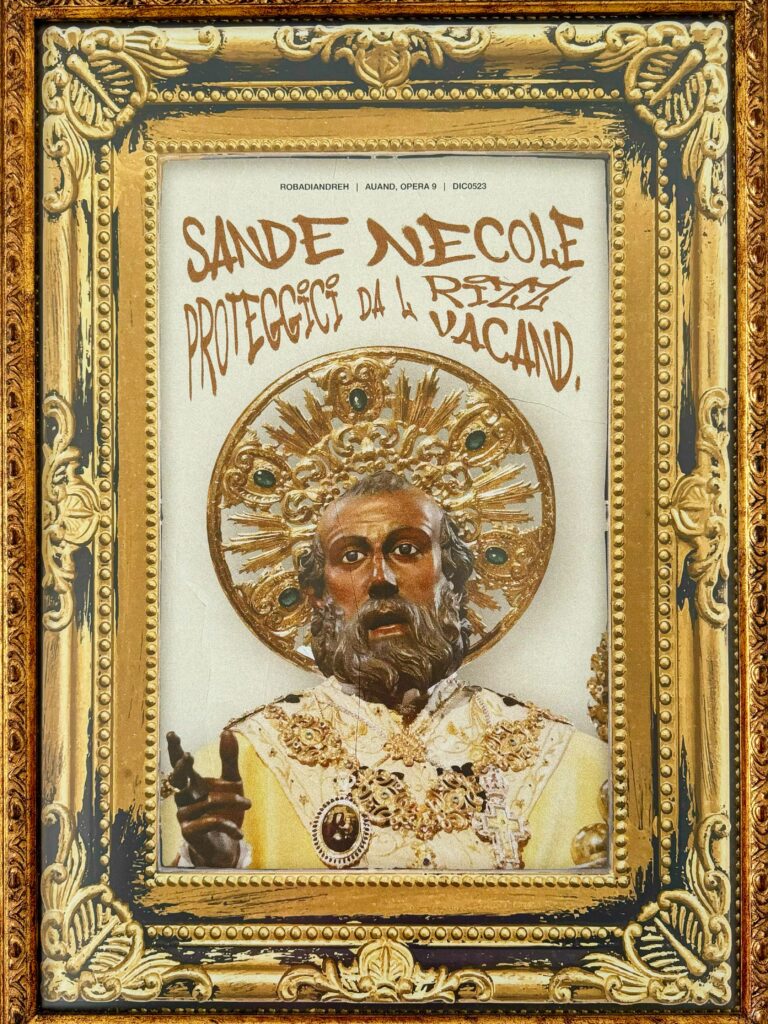
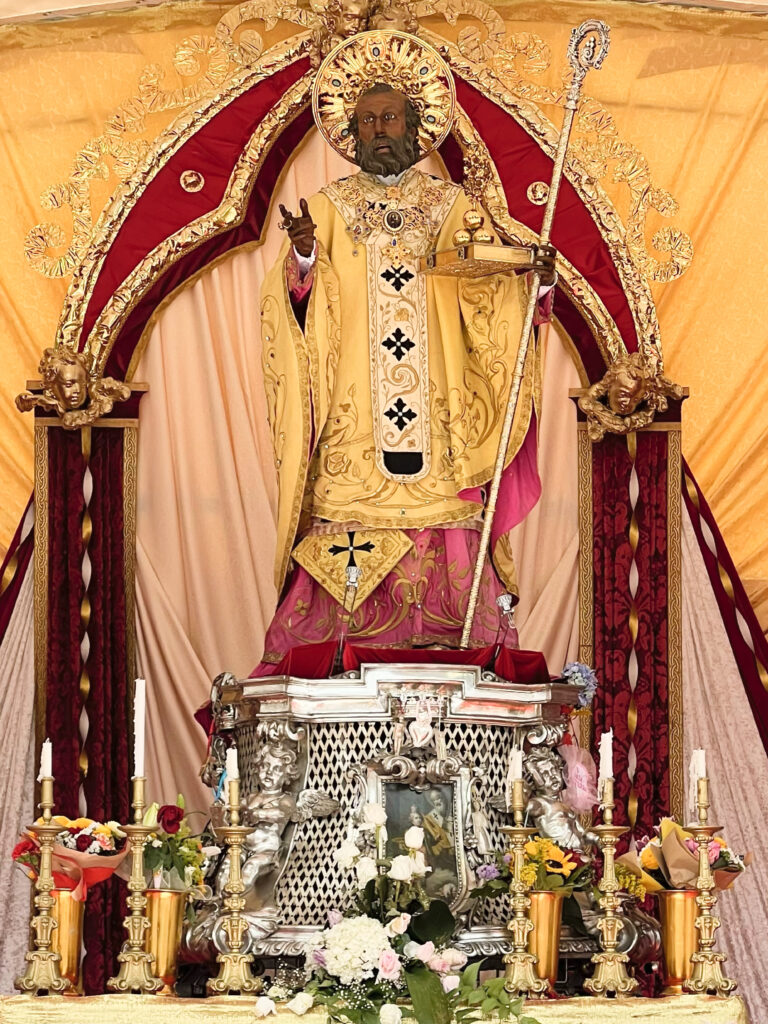
For fuller detail on San Nicolas, his connection with Bari and full details of the three-day May celebrations, check out our Saint Nicholas, Patron Saint of Bari Guide.
San Severo and the Fujenti: Dancing with Fire
Festive fires still take place. In San Severo, the fire is chased. Each May, as part of the celebrations for the Madonna del Soccorso, the town’s streets become an open-air arena for the fujenti: locals who run through the narrow alleys of the centro storico, and exploding pyrotechnics!
For the fujenti, chasing the fire is an act of devotion. The Madonna del Soccorso, known as “the black-faced mother”, is invoked in each roar of fire and flare of light.
Once over, bowls of pancotto, a stew made in the cucina povera tradition from wild greens and stale bread, accompanied by glasses of robust red regional wine, to reward those brave enough to dance with the fire.
Other festivals in May include
Festa del SS. Crocifisso – Galatone (LE)
From 1 to 4 May, Galatone celebrates its patronal festival with processions, fireworks, a traditional fair, and illuminations. Religious events centre on the Sanctuary of the Crocifisso, while civic celebrations include concerts and cultural displays, drawing crowds from across Salento.
Fiera di Sant’Irene – Lecce (LE)
Once Lecce’s patron saint, Sant’Irene is still honoured from 2 to 5 May with a triduum and a feast day Eucharist on 5 May. Historically associated with clay bells and household goods, the revived celebration connects past and present with religious observance and popular fair culture.
Festa del Crocifisso di Colonna – Trani (BT)
Held on 3 May, this sea procession commemorates the miraculous return of a crucifix thrown into the sea by Turkish pirates in 1480. The wooden crucifix is carried from the Monastero di Santa Maria di Colonna to Trani’s port and through the city streets, accompanied by fireworks and prayers.
Sagra della Puccia all’Ampa – Novoli (LE)
Held in early May in the hamlet of Villa Convento, this small but authentic food festival celebrates the puccia all’ampa, a rustic wood-fired bread typically filled with pickles or ricotta. Organised by the local Pro Loco, it marks the beginning of the outdoor dining season and features traditional fare in a convivial village setting.
Festa dei Santi Medici – Bitonto (BA)
Held in early May, this feast honours Saints Cosmas and Damian. The celebration includes religious processions, civic ceremonies, fireworks, and performances by traditional marching bands. It’s a key event in Bitonto’s cultural and spiritual calendar.
Festa di San Cataldo – Taranto (TA)
Celebrated from 8 to 10 May in honour of Taranto’s patron saint, an Irish monk who became bishop in the 7th century. Highlights include a sea procession with the saint’s statue aboard a naval vessel, the traditional “pregge” ceremony, musical performances, and fireworks launched from the Castello Aragonese.
Festa di San Nicola – Bari (BA)
From 7 to 9 May, Bari honours its patron saint with one of the city’s most important events. On 7 May, a historical re-enactment recalls the arrival of Saint Nicholas’ relics. On 8 May, his statue is taken out to sea in a boat procession. The climax is on 9 May, with the collection of the Holy Manna and solemn mass in the Basilica. The city comes alive with fireworks, music, illuminations, and thousands of pilgrims.
Otranto Truffle Festival – Corigliano d’Otranto (LE)
Held in May, this festival dedicated to the prized white truffle features local restaurant menus, cooking classes, truffle-hunting competitions, and live music. Although named after nearby Otranto, the event takes place in the village of Corigliano d’Otranto and celebrates Puglia’s lesser-known truffle-growing heritage.
Sagra della Ciliegia Ferrovia – Turi (BA)
From mid-May to early June, Turi hosts one of Puglia’s best-known food festivals celebrating the Ferrovia cherry, a variety prized for its size and sweetness. The streets fill with food stalls, cherry tastings, markets, concerts, and cultural events honouring the region’s agricultural excellence.
Concerto Primo Maggio – Taranto (TA)
This alternative May Day concert, known as Uno Maggio Taranto Libero e Pensante, combines music with social and environmental activism. Set in the Parco Archeologico delle Mura Greche, it is a grassroots event with major artists, debates, and campaigns for workers’ rights and environmental justice.
Cortili Aperti – Lecce (LE)
On the last Sunday in May, Lecce’s usually closed historic courtyards and gardens open to the public. Organised by the Associazione Dimore Storiche Italiane, the event includes guided tours, exhibitions, and performances, offering a rare glimpse into the city’s aristocratic past and architectural beauty.
Festa della Madonna della Coltura – Parabita (LE)
Held from 25 to 27 May, this colourful event honours the Madonna della Coltura, believed to have miraculously appeared to a farmer. It features the Corsa del Contadino (farmer’s race), processions, concerts, and a pyrotechnic display simulating a burning bell tower saved by the Virgin, symbolising her divine protection.
Festa della Madonna della Fonte – Conversano (BA)
Celebrated across two weekends: the first Saturday in May for the religious rites, and the fourth Sunday for the civic events. These include processions with the icon of the Madonna, petal showers, illuminations, a funfair, and the symphonic march Vita Pugliese. The Madonna is blessed as protector of the city, countryside, and sea.
Infiorata – Andria (BT)
Taking place in late May or early June to mark Corpus Domini, this floral festival sees the streets of Andria covered in elaborate carpets of flower petals. Designs often feature religious or social themes and are painstakingly created overnight by local artists and residents.
Festa di Santa Rita – Cisternino (BR)
Held on 22 May, this celebration includes the distribution of blessed roses, flower markets, and devotional processions. Santa Rita, known as the saint of impossible causes, is especially venerated by families and those seeking comfort and healing.
Sagra dell’Aquillone – Polignano a Mare (BA)
Held on 26 May at Largo Grotta Ardito, this 61st edition kite festival features creative competitions, sea-themed decorations, and prizes for the most beautiful and highest-flying kites. It’s a family-friendly event with music, children’s activities, and school collaborations.
Cherry Festival – Leverano (LE)
Known locally as Fiera ti li cirase, this festival is held on the fourth Sunday in May. It features cherry tastings, agricultural displays, and local crafts. It is part of a broader celebration of the Ferrovia cherry across Puglia, especially in Turi and Conversano.
Festa di San Nicola – Bari (BA)
Also commemorated on 6 December, the May edition includes the sea procession and historical re-enactments. It represents a cornerstone of the city’s religious identity, especially with the retrieval of the manna from the saint’s tomb, believed to have miraculous properties.
Sagra del Carciofo Violetto – Cerignola (FG)
This sagra celebrates the violet variety of Cerignola artichokes, typically in the first week of May. Local chefs and producers present traditional and modern artichoke recipes, along with tastings, cooking workshops, and folk performances.
Disfida di Barletta – Barletta (BT)
A re-enactment of the famous 1503 duel between Italian and French knights, this historical pageant includes processions in period costume, staged tournaments, and medieval-themed events across the city. It offers a dramatic retelling of Puglia’s Renaissance-era pride.
Corteo Storico Federiciano – Andria (BT)
Taking place on the third Sunday in May, this impressive historical parade celebrates Emperor Frederick II with medieval costumes, falconry displays, and performances recalling the splendour of his Swabian court. The event culminates in a dramatic public spectacle.
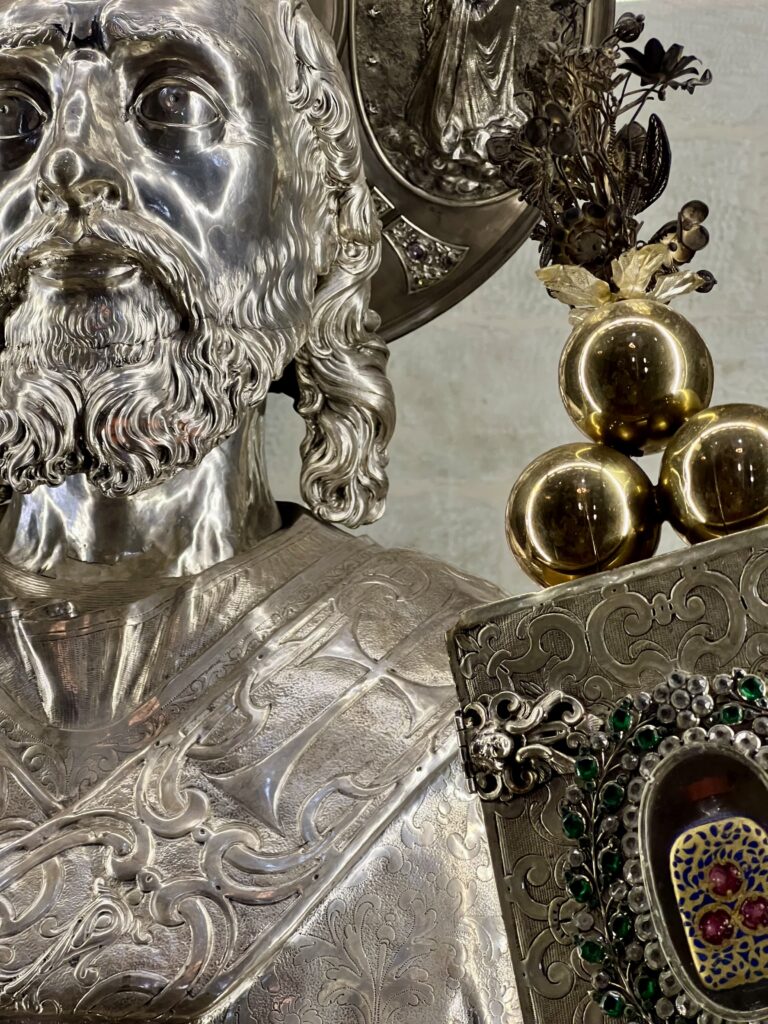
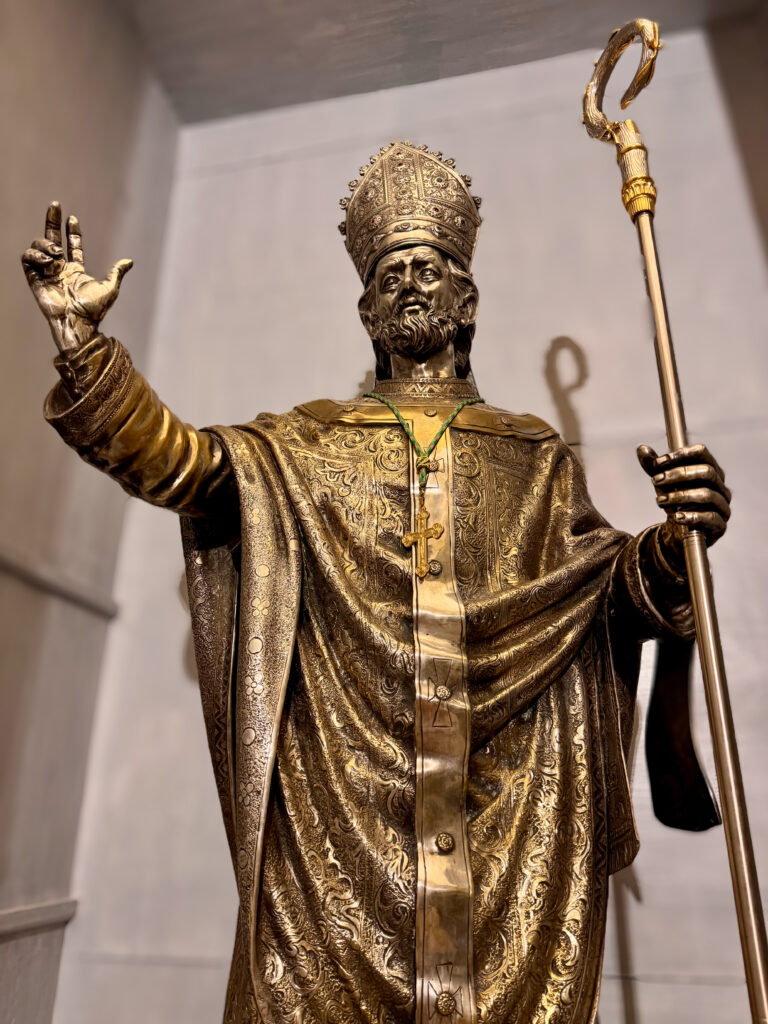
Summer Festivals of Light and Flame in Puglia: The Season of Saints, Spectacle and Sound
As spring gives way to summer in Puglia, the flicker of winter bonfires yields to a radiant theatre of light, colour and ritual. From the ancient towns of Salento to the heartlands of the Terra di Bari, festival season intensifies, bringing with it illuminated streets, and epic fireworks displays.
This is Puglia’s other fire – of electricity, pyrotechnics and passion — a celebration of saints and survival in a land where sacred tradition and popular devotion still set the calendar alight.
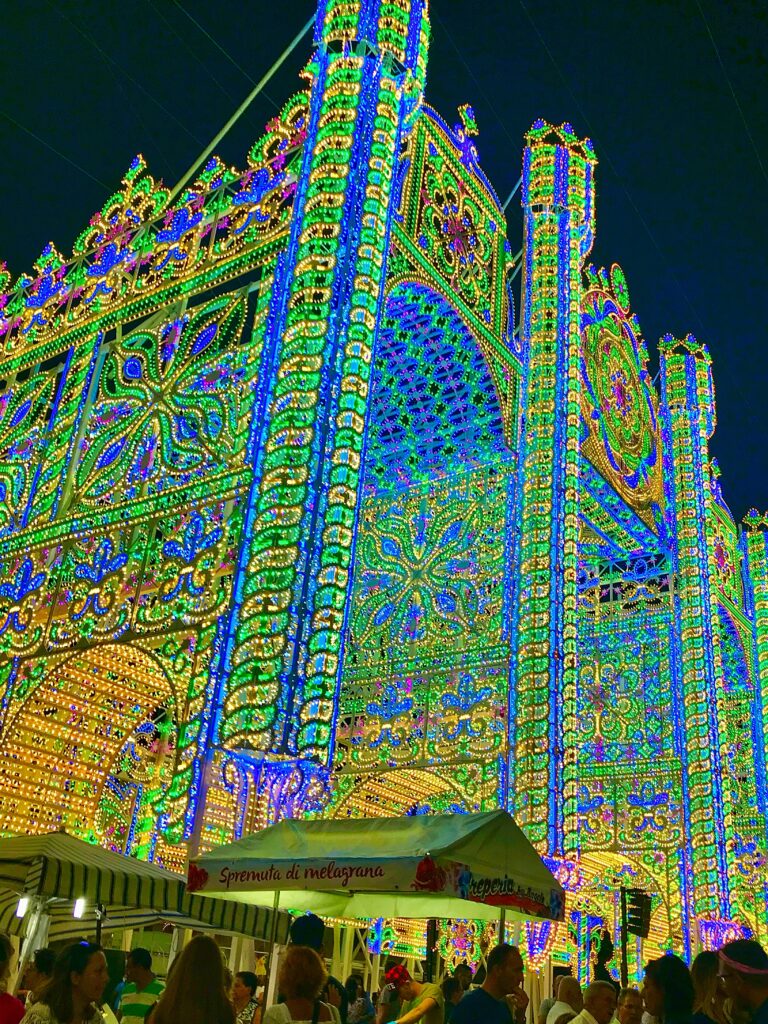
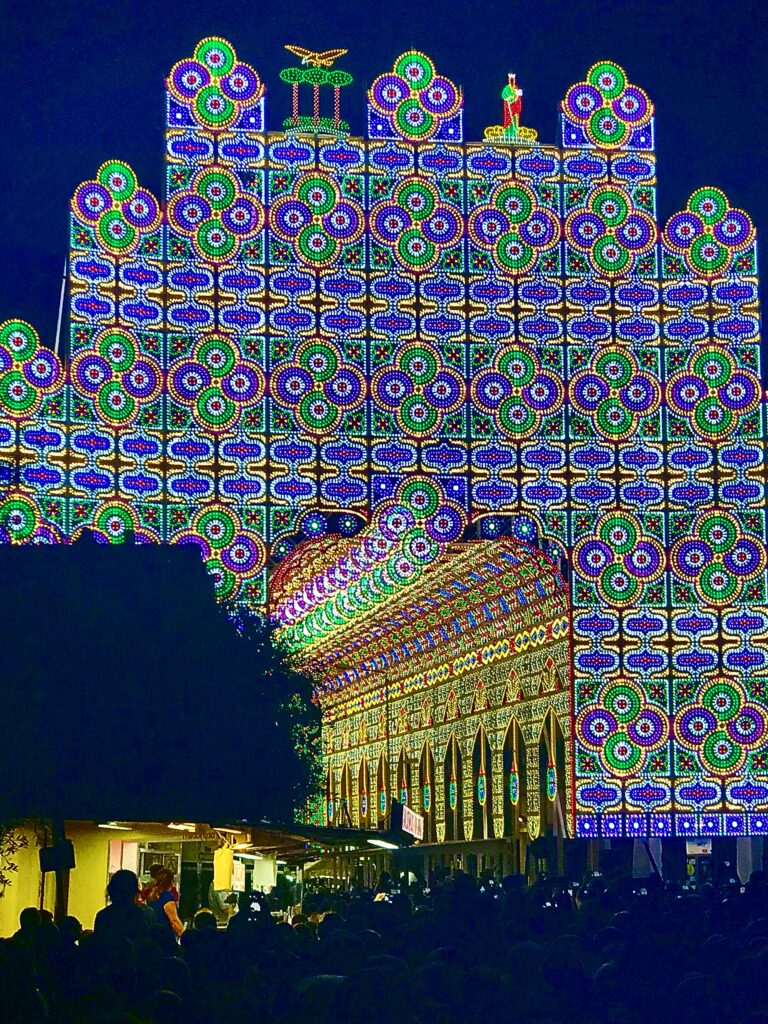
Salento’s Cathedrals of Light
Over the summer months elaborate luminarie are on display. These are more than festive decorations, constructed from wooden arches and tens of thousands of coloured bulbs. Towering above town squares, framing churches, and flanking winding alleys, they pulse to music in synchronised displays, blending Baroque grandeur with modern lighting technology.
From May onwards, Salento hosts a calendar full of festivals that merge these architectural light displays with food, music and tradition. In Diso, the Festa dei Santi Nosci celebrates Saints Philip and James with concerts, fireworks, and local dishes like pittule (fried dough balls), scapece (fried, saffron-marinated fish), and ciceri e tria, a pasta and chickpea dish with ancient origins.
In Galatina, June’s celebration of Saints Peter and Paul transforms the town. Once a pilgrimage site for the tarantolati – women afflicted with the tarantula’s bite – the town pulses with the rhythm of pizzica dance, and a celebration of Galatina’s DOP-certified new potatoes.
But perhaps the most impressive and best-known light display in Puglia occurs in Scorrano each July, during the Festa di Santa Domenica. Here, generations of master illuminators compete with towering “walls” of illumination, synchronised with classical music and digital animations.
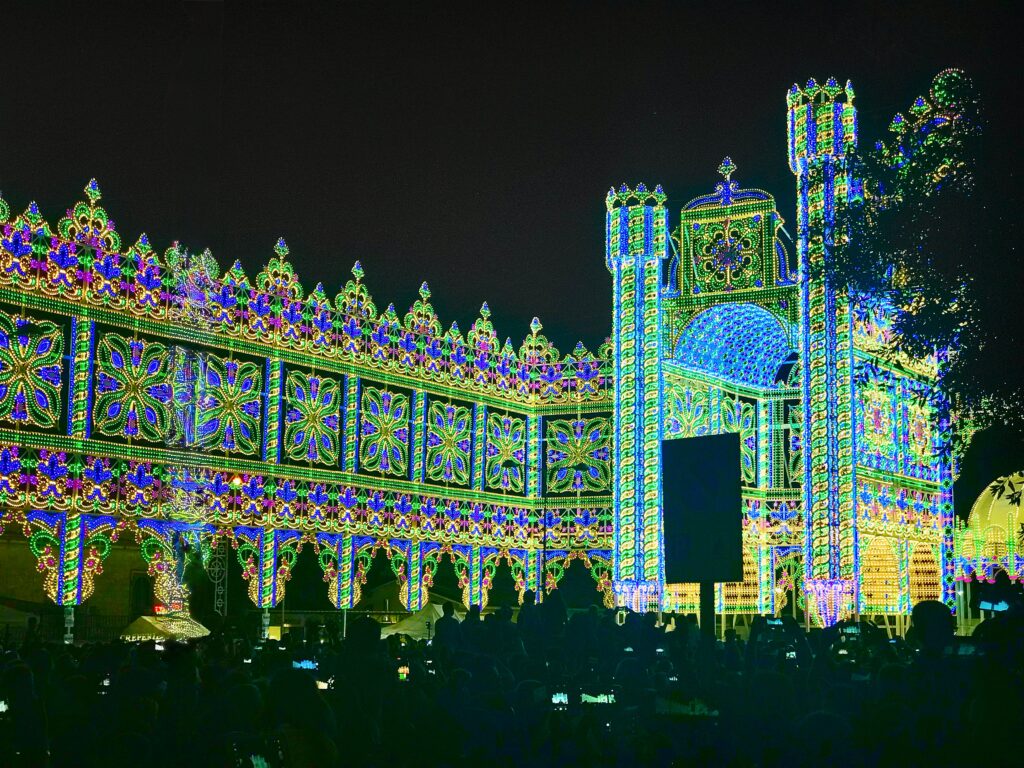
June | Popping Puglia’s Cherry Plus Polpo
In June we have a chance to enjoy the region’s early summer produce, music, maritime traditions, and more patroni di Puglia!
Voci in Ascolto – San Vito dei Normanni (BR)
Curated by the World Music Academy, Voci in Ascolto is a programme of vocal workshops and public performances, featuring traditional music from the Salento area and in dialects from across southern Italy. It brings together renowned artists and participants. The programme includes concerts, sacred singing, and polyphonic vocal traditions in evocative settings such as historic chapels and rural masserie.
Sagra della Ciliegia Ferrovia – Turi (BA)
Held on 1–2 June in 2024, this long-running cherry festival celebrates the iconic Ferrovia variety. Markets, cherry tastings, food stalls, and traditional music take over the town. It is jointly promoted with nearby Conversano and symbolises Puglia’s cherry-growing pride.
Festa di San Vito – Polignano a Mare (BA)
From 14 to 16 June, Polignano a Mare honours its patron saint San Vito Martire. The highlight is a sea procession that brings the saint’s statue from the coastal hamlet of San Vito to the town. Celebrations include religious services, live music, and a grand fireworks display, filling the seaside town with festive atmosphere.
Medimex – Taranto (TA)
Puglia’s leading international music conference and festival, Medimex transforms Taranto into a hub for music lovers and professionals each June. Organised by Puglia Sounds, it features high-profile concerts, talks, exhibitions, and industry networking events. Past editions have hosted global acts such as Patti Smith, Editors, and Kraftwerk. Concerts often take place at open-air venues like the Rotonda del Lungomare, combining sea views with electrifying performances. 2025 headliners include St. Vincent, Primal Scream and Massive Attack.
Leverano in Fiore – Leverano (LE)
An international flower festival held in early June, this event transforms Leverano’s historic centre into a giant garden. Florists from across Europe create imaginative floral installations, with prizes for the best displays. The event includes music, tastings, and floral-themed parades.
Festa dei Lampioni e de lu Cuturusciu – Calimera (LE)
Celebrated on 21–22 June, this midsummer festival features elaborate paper lanterns (lampioni) lit at night in honour of San Luigi. Alongside the light displays, visitors enjoy the traditional cuturusciu, a sweet bread typical of the area. The lanterns create a magical atmosphere across the historic centre.
Festa di San Giovanni Battista – Bari (BA)
Celebrated on 24 June with religious processions, the blessing of boats, and the traditional “flight of the angel,” symbolising divine protection. Events are held along the waterfront, combining spiritual tradition with festivity.
Feast of Saints Peter and Paul – Galatina (LE)
From 28 to 30 June, Galatina celebrates its patron saints, Peter and Paul, with processions, concerts, and fireworks. On 29 June, the ballo delle tarantate takes place in front of the Chapel of San Paolo—a ritual pizzica dance historically linked to healing women believed to be bitten by tarantulas. The celebration is deeply entwined with the history of tarantismo.
Sagra del Centro Storico – Otranto (LE)
Coinciding with the Feast of Saints Peter and Paul on 28–29 June, this event opens the summer season in Otranto. Organised by a local cultural association, the festival fills the old town with Salento folk music, traditional food stands, and performances celebrating Otranto’s identity and coastal heritage.
Sagra del Polpo – Mola di Bari (BA)
This seafood festival celebrates Mola di Bari’s fishing traditions with dishes like grilled octopus and octopus salad. Visitors enjoy tastings, seaside music performances, and street food in the town’s picturesque port area.
Parata dei Giganti – Alberobello (BA)
In late June, Alberobello hosts this whimsical parade of giant papier-mâché figures representing mythological and historical characters. The procession is accompanied by folk musicians and dancers, creating a lively summer celebration in the trulli town.
Festa Patronale di San Pietro e Paolo – Taranto (TA)
Held on 29 June, this patronal feast includes solemn processions, traditional music, and a firework display. The community comes together to honour the apostles Peter and Paul, protectors of the city.
Antica Fiera di San Pietro – Monte Sant’Angelo (FG)
Also on 29 June, this historic fair is one of the oldest in southern Italy. It features artisan markets, traditional foods, and medieval re-enactments within the UNESCO-listed old town.
Infiorata del Corpus Domini – Noci (BA)
Linked to the feast of Corpus Domini (variable date), the old town of Noci is transformed with elaborate floral carpets created entirely from flower petals. These intricate artworks line the streets for a single day, culminating in a religious procession.
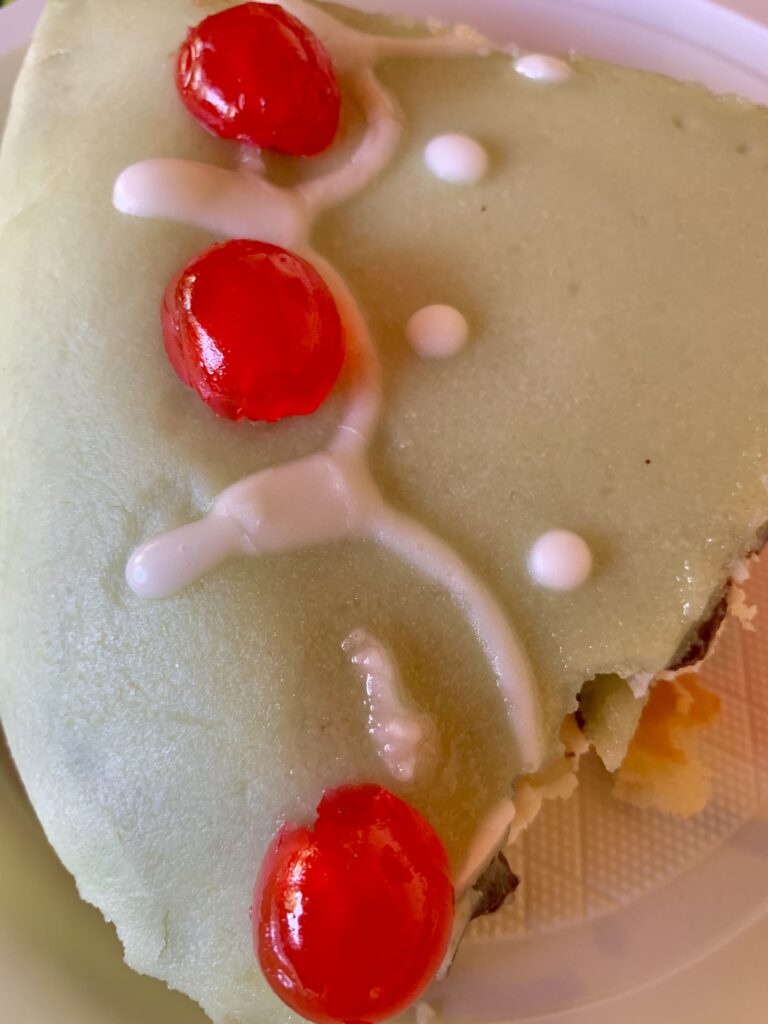
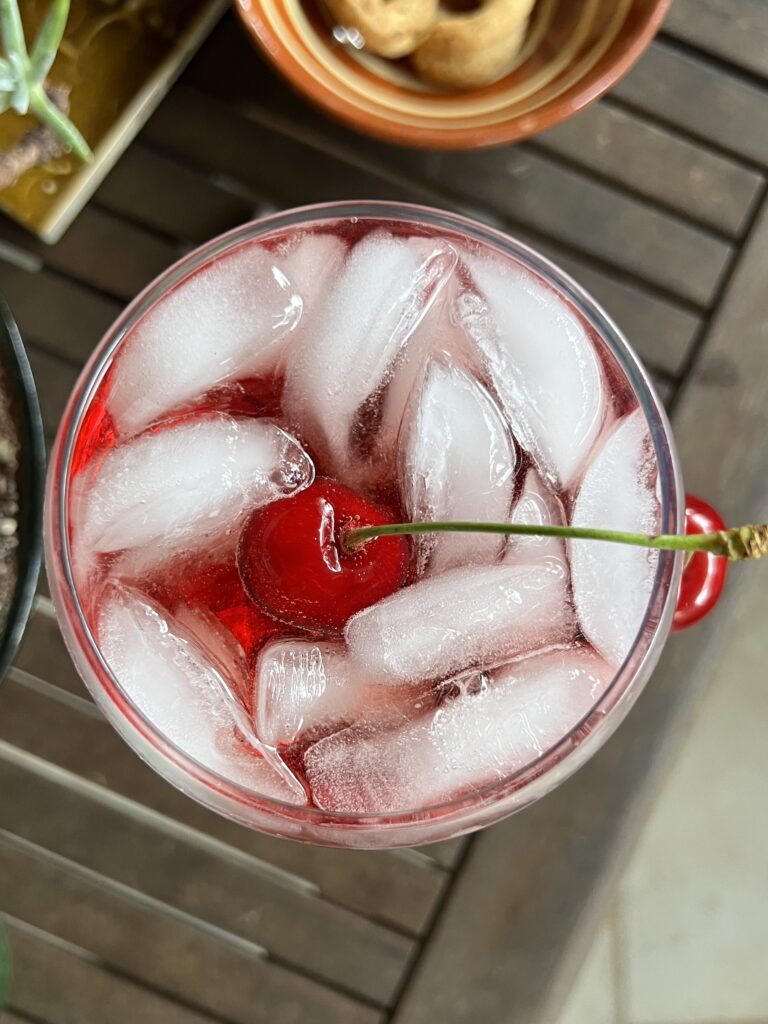
July in Puglia | Music Festivals, A Fry-Up and Snails
With summer in full swing, the festival season is packed full.
Sagra delle Frittelle – Latiano (BR)
Held on 1 July, this festival celebrates the beloved fritter with a variety of sweet and savoury recipes. Live music, folk dancing, and artisan stalls accompany the food, making for a festive atmosphere in the town’s streets.
Beer ‘n’ Food Festival – San Pancrazio Salentino (BR)
Running from 5 to 7 July, this modern celebration pairs craft beers with local culinary specialities. Concerts, tastings, and food trucks fill the piazza in a vibrant festival setting.
Festa del Mandorlo – Specchia (LE)
Dedicated to the almond tree, this early July festival includes tastings of almond-based dishes and sweets, cultural activities, and folk performances. It celebrates both the agricultural and culinary importance of almonds in Puglia.
Sagra dell’Insalata Grika e della Salsiccia – Martignano (LE)
Taking place mid-July, this sagra highlights the Grika salad – a traditional dish from the Greek-speaking communities – and local sausage. The event includes tastings, dancing, and music that reflect Martignano’s unique heritage.
Puglia Tipica – Ortelle (LE)
Held around 13–14 July, this festival explores the culinary history of Puglia with traditional recipes, food tastings, and historical re-enactments. Visitors can sample rare and ancient dishes prepared by local chefs and nonne.
Il Cibo di San Vito Festival – San Vito dei Normanni (BR)
From 13–15 July, this food festival brings together traditional Puglian cuisine, pizzica music, and street food culture. Dishes range from classic peasant fare to more creative interpretations.
Coreutica – San Vito dei Normanni (BR)
A week-long residency on Mediterranean music and dance, Coreutica offers workshops, public performances, and site-specific events rooted in the traditions of southern Italy. Hosted at ExFadda and across the local landscape, the festival fosters artistic exchange, community participation, and a deep connection to place. The eleventh edition takes place from 13-20 July 2025. It remains a national reference point for the pizzica and Mediterranean dance scene. (Featured in main photo).
Festa delle Friselle – Nociglia (LE)
Held on 16 July, this event celebrates the frisella, a twice-baked Puglian bread often served with tomatoes and olive oil. The festival features tastings, cooking demonstrations, and folk entertainment.
Sagra dell’Orecchietta – San Michele Salentino (BR)
Also on 16 July, this festival showcases the region’s iconic orecchiette pasta, prepared in classic and innovative styles. Workshops and music create a festive atmosphere.
Sagra de lu Pesce – Porto Cesareo (LE)
From 14 to 16 July, this seafood sagra features traditional dishes like lu quaturu (fish soup), fried fish, music, and the Palio di Porto Cesareo with local fishermen competing in a rowing race in traditional boats. Workshops on how to recognise fresh fish add an educational element to the seaside celebration.
Le Vie del Miele – Meledugno (LE)
Also mid-July, this honey-themed event includes tastings, beekeeping demonstrations, and workshops on honey-based products. It’s a sweet celebration of local craftsmanship and biodiversity.
Sagra Saracina – Collepasso (LE)
Focusing on saracina, a traditional grain, this event features rustic dishes, music, and dancing. It’s an opportunity to sample lesser-known Puglian recipes in a lively village setting.
Sagra del Pane e dell’Olio – Altamura (BA)
Throughout July, Altamura’s sagra honours its famous DOP bread and local olive oil. Tastings, bakery tours, and olive oil pressing demos provide a rich gastronomic experience.
Festa del Mare – Polignano a Mare (BA)
Late July in Polignano sees swimming contests, sea-themed performances, and fireworks lighting up the cliffs. The festival honours the town’s relationship with the sea and its fishing traditions.
Festival della Valle d’Itria – Martina Franca (TA)
One of Italy’s premier opera festivals, held throughout July in Martina Franca. Performances are staged in iconic venues such as the Palazzo Ducale and the cloister of San Domenico. The 49th edition in 2024 featured works like Rossini’s The Turk in Italy and rare operatic premieres, accompanied by concerts, workshops, and masterclasses. The festival attracts international audiences and showcases both Baroque and contemporary works.
Locus Festival – Locorotondo (BA)
Beginning in July and continuing into August, Locus Festival brings international artists and a mix of genres—from Afrobeat and jazz to electronic and world music—to the Valle d’Itria. Events are held in Locorotondo’s historic centre and surrounding masserie. With its immersive soundscapes and rural backdrops, the festival is a highlight of Puglia’s contemporary cultural calendar.
Forum Wine Festival (Terre del Negroamaro Fest) – Guagnano (LE)
Held on 19–20 July, this festival celebrates Negroamaro wine with tastings, cooking shows, and food pairings in Guagnano’s historic centre. The event also includes talks on enotourism and climate change, live music, and cultural performances—all set among illuminated courtyards and wine cellars.
Festa di Santa Domenica – Scorrano (LE)
Known as the “capital of lights,” Scorrano hosts one of the most dazzling patronal festivals from 5 to 9 July. Massive luminarie light installations are synchronised to music, attracting lighting companies from across Italy. The celebration includes religious processions, fireworks, concerts, and food stalls, drawing tens of thousands of visitors each year.
Sagra de lu Ranu – Merine (LE)
Held from 21 to 23 July in the village of Merine, this “wheat festival” celebrates Salento’s rural traditions. Dishes made from local grain—bread, pasta, focaccia—are served with live music and folk dancing. The event celebrates the importance of grain in the region’s agricultural and culinary identity.
Festa te la Uliata – Caprarica di Lecce (LE)
From 28 to 31 July, Caprarica celebrates the uliata, a rustic focaccia bread with olives. Visitors enjoy four nights of food, pizzica music, and dancing. A quirky highlight is the olive pit spitting contest (gara dello sputo del nocciolo), adding fun to this deeply traditional and communal event.
Cavalcata Storica – Nardò (LE)
From 28 to 30 July, Nardò hosts a grand historic pageant with costumed processions, exhibitions, and reenactments. The medieval-style parade features knights on horseback and participants in Renaissance garb, culminating in a horse parade through the historic centre. Side events include feasts, guided tours, and cultural displays celebrating the town’s noble past.
Jazz in Galatina – Galatina (LE)
Usually held in early July, this open-air jazz festival brings international musicians to piazzas and courtyards across Galatina. The town becomes a stage for sophisticated summer nights.
Sagra della Municeddha – Cisternino (BR)
This local sagra celebrates snail-based cuisine, offering rare recipes from local tradition. It’s a unique opportunity for food lovers to explore an often-overlooked delicacy.
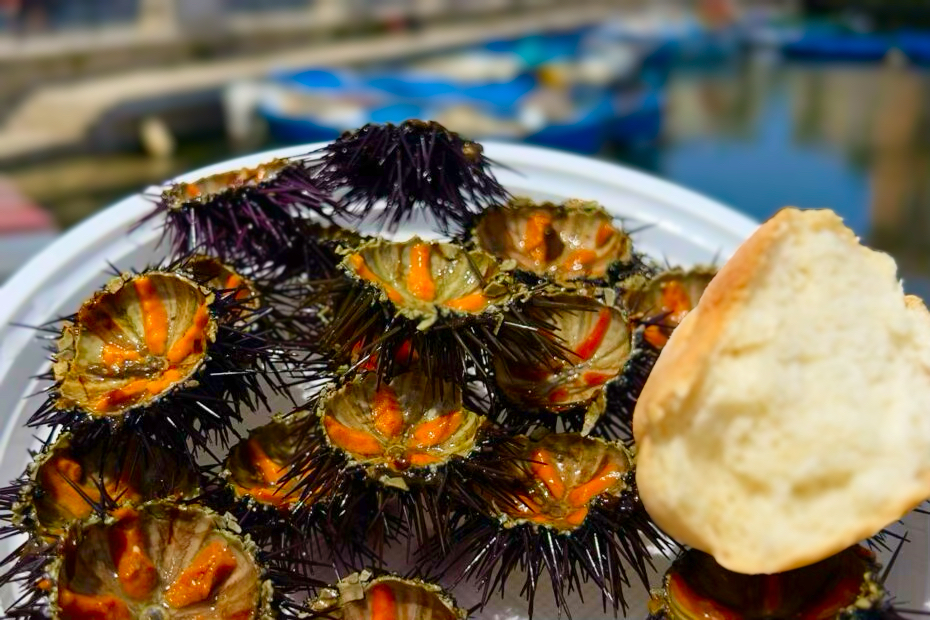
Intervallo | The Joy of Puglia’s Sagre Food Festivals
Sagre festivals embody the Pugliese spirit. These communal feasts are vibrant, welcoming occasions. There is no better way to understand the importance of our regional cooking.
From Sagre to Food Festivals
In recent years, a new wave of food and wine festivals has emerged. Inspired by international trends, these events – such as the EGO Food Festival – offer a more refined, immersive experience while still honouring local producers and produce.
Here, starred and non-starred chefs, local producers, artisans and experts come together to curate tasting and educational experiences (with presentations and workshops) as well as offering marketplace experiences. It’s no longer just about eating or drinking, but about experiencing the region through its flavours, stories, and excellences.
The balance between tradition and innovation honours both the authentic and modern culinary culture of Puglia.
What are Sagre Festivals?
Sagre (plural of sagra) are local festivals that celebrate a particular food, product, or tradition unique to the area. These festivals often include food stalls, music, dancing, and sometimes even parades or historical reenactments. They provide a way for locals and tourists alike to experience the authentic flavors and culture of the region.
Puglia’s sagre food festivals showcase local cuisine, cooking traditions, and culture. While not unique to Puglia—sagre festivals are one of Italy’s best-kept food secrets—food is an integral part of our region’s identity. These are intensely social occasions where you are as likely to feast side by side with locals as with strangers.
Many sagre have their roots in local harvest traditions and pagan festivals, celebrating a new crop of seasonal produce. The chance to feast is at the heart of many celebrations in Puglia.
Most sagre feature local producers bringing their goods to stalls, offering demonstrations and tastings. But a sagra is not just about the food. These are welcoming social occasions, the glue that binds us. Local culture and traditions are showcased with luminarie and fairy lights decorating the streets and squares to create impromptu al fresco dining spaces. In the background, tamburelli beat the fevered rhythm of traditional pizzica.
You will find something happening in every alley and on every street corner, even in the semi-private courtyards where locals prepare food at home to share with whoever may pass by.
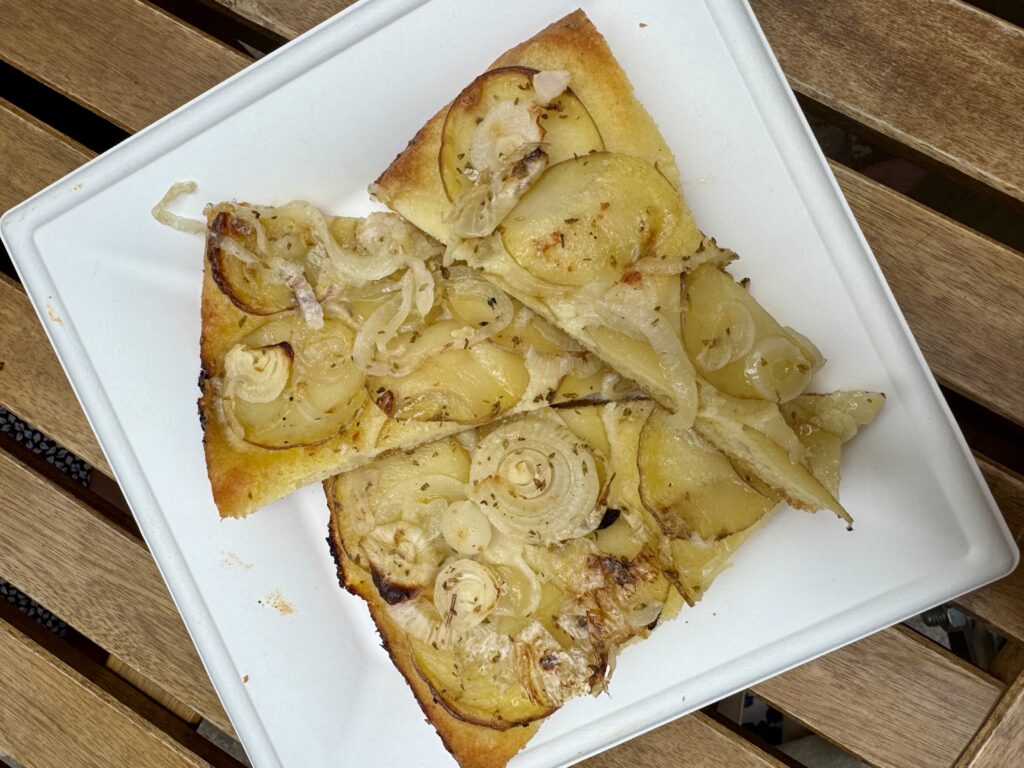
Why Visit Puglia’s Sagre Festivals?
- Culinary Delights: Taste the best of Puglia’s traditional foods, from fresh seafood to artisanal cheeses and homemade pastas.
- Cultural Immersion: Experience the local customs, music, and dances that have been passed down through generations.
- Community Spirit: Enjoy the warm hospitality and festive atmosphere as locals come together to celebrate their heritage.
Tips for Enjoying Sagre Festivals
- Arrive Early: Festivals can get crowded, especially in the evening. Arriving early ensures you get to sample the best foods.
- Bring Cash: While some vendors may accept cards, it’s a good idea to have cash on hand for smaller stalls.
- Dress Comfortably: Wear comfortable clothing and shoes, as you’ll likely be walking and standing a lot.
- Engage with Locals: Don’t be shy—engage with the locals to learn more about the traditions and foods being celebrated.
Conclusion
Puglia’s sagre festivals offer a feast for the senses and a deep dive into the region’s rich cultural and culinary heritage. Whether you’re a foodie, a culture enthusiast, or just looking for a lively and authentic experience, visiting these festivals is a must. Plan your summer trip to Puglia around these events and prepare to indulge in some of the finest food celebrations Italy has to offer.
August in Puglia
August is the peak of summer in Puglia. The rest of Italy shuts down and comes to vacation on our beaches, and enjoy the region’s food. Puglia positively pulses with buzzing energy, culminating in the Ferragosto national holiday.
Mercatino del Gusto – Maglie (LE)
From 1 to 6 August, Maglie becomes an open-air market celebrating Puglia’s gastronomic excellence. Dozens of stalls line the streets offering local cheeses, cured meats, wines, desserts, and olive oil. The programme includes cooking shows, tastings, workshops, and cultural events, making it one of the region’s most anticipated summer food festivals.
Sagra te lu Purpu – Melendugno (LE)
Held from 5 to 8 August, this popular octopus festival features purpu prepared in various ways—grilled, stewed, in salads, or in traditional pignata. The event is accompanied by live pizzica concerts and folk dancing each evening, attracting seafood lovers from across Salento.
Festa di San Domenico – Taranto (TA)
In the first week of August, this feast includes a religious procession alongside exhibitions, concerts, and community events. It brings together faith and civic pride in one of Taranto’s most important annual observances.
Festa della Municeddha – Cannole (LE)
From 10 to 14 August, this renowned snail festival celebrates the municeddha, or small edible snail, with dishes like roasted or stewed snails, alongside local street foods. The village is transformed with music, dancing, artisan stands, and a cocktail bar area, making it one of northern Salento’s signature summer events.
Sagra del Fico Mandorlato – Castrignano del Capo (LE)
Mid-August sees this sweet celebration dedicated to the local variety of almond-stuffed figs. Visitors can sample fig-based desserts, jams, and traditional recipes, while enjoying craft markets and musical performances in a festive Salento setting.
Festa di San Lorenzo – Vieste (FG)
Celebrated on 10 August during the Notte di San Lorenzo (night of the shooting stars), this event blends religious and folkloric elements with a procession, beachside picnics, concerts, and a grand fireworks display under the stars.
Sagra della Salsiccia – Martina Franca (TA)
Held in early August, this sausage festival celebrates Martina Franca’s famous grilled sausage, a local delicacy often paired with wines from the Valle d’Itria. The event features food stalls, tastings, live music, and folk dancing in the historic centre.
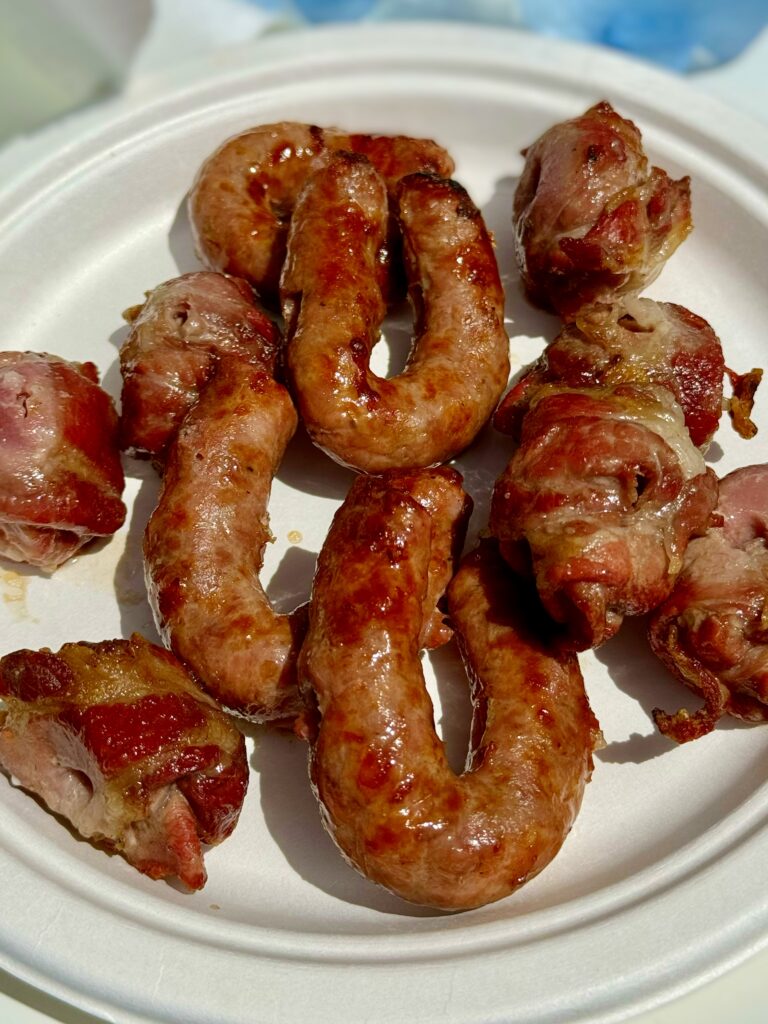
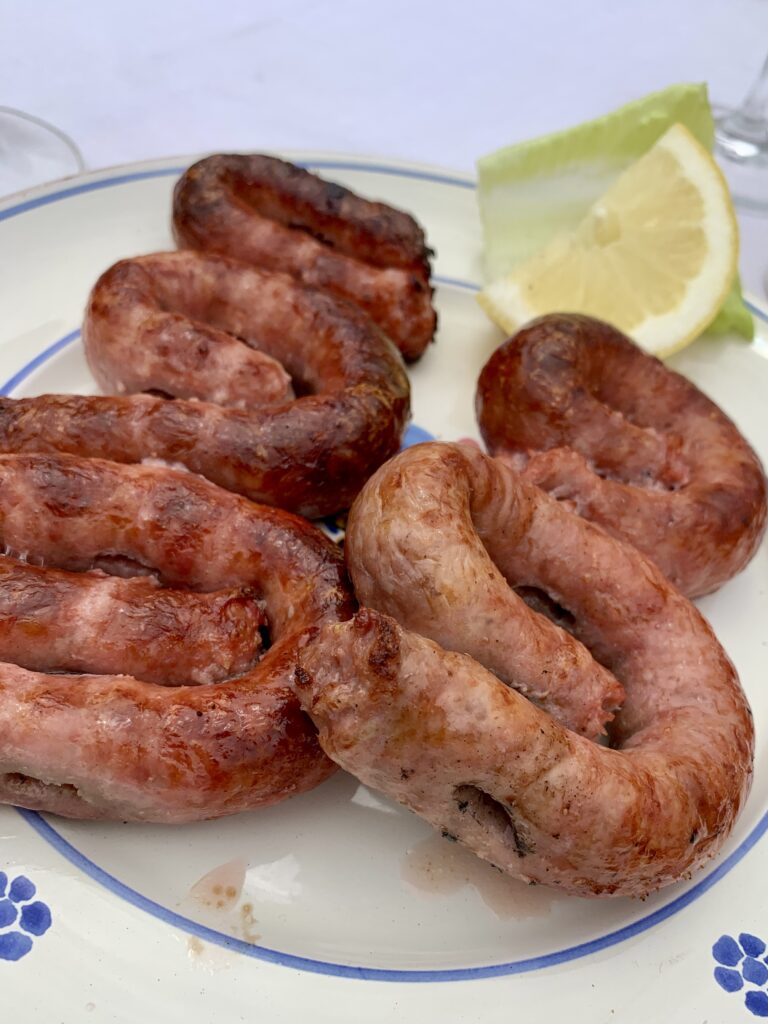
Ferragosto – Across Puglia
15 August marks Italy’s high summer holiday, Ferragosto, with beach parties, music festivals, barbecues, and town-wide celebrations. In Puglia, nearly every town and seaside resort hosts its own festivities, from fireworks to family picnics.
Festa di Santa Maria di Leuca – Santa Maria di Leuca (LE)
Also held on 15 August, this coastal celebration features a striking maritime procession in honour of the Madonna, culminating in fireworks and land-based festivities that draw pilgrims and tourists alike to the tip of the Salento.
Festa di San Rocco – Torre San Giovanni (LE)
On 16 August, the town comes alive with a religious procession followed by music, dancing, and fireworks. It’s a joyful blend of faith and summer celebration on the Ionian coast.
Sagra del Pesce Spada – Gallipoli (LE)
In mid-August, Gallipoli celebrates its maritime traditions with a swordfish festival that offers a variety of seafood dishes including fried paranza, grilled cuttlefish, swordfish steaks, orecchiette with scampi, and octopus stews. Cheese platters and local wines complete this summer feast by the sea, accompanied by concerts and folk performances in a festive atmosphere.
Palio di Taranto – Taranto (TA)
Usually held in August, this historic regatta sees different districts of Taranto compete in rowing races along the waterfront. A proud expression of local rivalry and maritime tradition, the palio is a highlight of the summer.
Sagra della Zampina, del Bocconcino e del Buongustaio – Sammichele di Bari (BA)
Held in late August, this food festival is a carnivore’s dream, featuring the local sausage zampina alongside other meat specialities and regional dishes. Music and street performances accompany the tastings in this lively village celebration.
Festa di Sant’Oronzo – Lecce (LE)
From 24 to 26 August, Lecce honours its patron saint Sant’Oronzo, credited with saving the city from the plague. The historic centre is decorated with luminarie, and celebrations include religious processions, a street market, fireworks, and concerts. Towns like Ostuni also celebrate the saint with their own events, reinforcing his regional significance.
Festa di Sant’Oronzo – Ostuni (BR)
From 25 to 27 August, the White City celebrates its patron saint with a grand cavalcade. Decorated horses and riders escort the saint’s effigy through the town, while concerts, processions, and fireworks complete one of Puglia’s most iconic religious festivals.
Sagra del Pesce Fritto – Castro (LE)
On 25 August, Castro hosts a fried fish festival featuring freshly caught seafood. Set in the scenic port area, the event includes food stands, live music, and local crafts, creating a festive evening that celebrates both coastal cuisine and community spirit.
Sagra del Pesce – Vieste (FG)
This seafood festival, usually held in August, offers fresh fish dishes prepared on the spot. The seafront becomes a centre for tasting traditional recipes, with music and street theatre adding to the coastal atmosphere.
Festa di San Rocco – Torrepaduli (LE)
This celebration in August is renowned for the danza delle spade (sword dance), a traditional mock combat performed to the rhythm of pizzica. The event blends sacred and profane in one of Salento’s most iconic folk rituals.
La Notte della Taranta – Melpignano (LE)
Held in late August, this is Italy’s largest music festival dedicated to traditional pizzica dance and music. The festival tours various towns in Salento before culminating in the Concertone finale in Melpignano on 24 August, drawing over 150,000 people. Each edition features a guest maestro concertatore who reinterprets pizzica in fusion with genres like rock, jazz, and classical.
September to November | Autumn in Puglia and Saints of the Harvest
As summer’s blaze softens into autumn’s golden hush, Puglia enters one of its most evocative seasons. The scent of must and figs drifts through the air, olive groves tremble with activity, and the countryside glows under gentler skies. Here, festivals don’t clamour — they nourish. Rooted in gratitude, rural rhythms, and the sacred pulse of the land, autumn celebrations in Puglia are generous, grounded, and deeply felt.
San Martino – The Feast of New Wine
Celebrated on 11 November, San Martino is the day “every must becomes wine.” Across the Valle d’Itria and wine-growing towns like Martina Franca and Locorotondo, cellars swing open and homes fill with the warmth of roast chestnuts, cured meats, and brasciole simmering in sauce.
Glasses are raised with still-cloudy vino novello, sipped in celebration and quiet judgement of the year’s yield. Children carry lanterns in honour of the saint who once shared his cloak on a cold night — a symbol of harvest generosity and communal care. It’s a night where faith meets fermentation, and the harvest becomes shared joy.
The Olive Harvest and Rural Rituals
From Fasano to Carovigno, the olive harvest shapes the rhythm of October and November. Families gather olives by hand or net, and the frantoi (oil mills) press through the night.
Though less formal than other festivals, the rituals are just as sacred. Some villages bless the oil, others hold simple masses in honour of saints like San Michele or Santa Maria della Misericordia.
In towns like Cisternino or Carpignano Salentino, market stalls offer freshly pressed oil, olives in brine, pittule, and sweets made with mosto cotto (cooked grape must). These feasts are quiet, humble, and deeply authentic — proof that sometimes the richest celebration is a piece of bread dipped in new oil.
Saint Protectors of the Fields
Many autumn festivals are devoted to saints invoked to guard the land and its yield. In Laterza, San Michele Arcangelo is honoured in late September with rural blessings and pan cotto made from wild greens and old bread — a dish of scarcity, memory, and resilience.
Elsewhere, in places like Minervino Murge or San Marco la Catola, November processions end with ritual fires in the fields — echoes of pre-Christian rites, now wrapped in prayer but still rooted in the old cycles of purification and rebirth.
Autumn in Puglia is about substance.
September Song
September brings a plentiful harvest and a glut of local produce.
Sagra della Municeddha – Cisternino (BR)
A continuation of the July event, this September edition offers another opportunity to taste municeddhe (local snails) prepared in traditional ways. Family-friendly and flavourful, the festival includes food stalls, music, and dancing.
Festa di Santa Maria di Leuca – Santa Maria di Leuca (LE)
Celebrated again on 8–9 September, the town honours its patron Madonna with processions by land and sea, concerts, fireworks, and devotional gatherings. It’s a deeply rooted event that brings together residents and pilgrims.
Festa di San Michele Arcangelo – Monte Sant’Angelo (FG)
On 29 September, the sanctuary town honours Saint Michael with torchlit processions, fairs, and musical events. The festival pays tribute to the archangel’s legendary apparition here in the 5th century, attracting pilgrims and visitors alike.
Tarantella Festival – Diso (LE)
Mid-September in Diso is dedicated to the tarantella, with traditional music performances, workshops, and dancing in the town’s piazzas. The festival celebrates the preservation and revitalisation of this lively folkloric tradition.
Sagra dell’Uva – Locorotondo (BA)
Held on the third weekend of September, this grape festival includes vendemmia-themed parades, wine tastings, and traditional music. Floats decorated with scenes from the harvest wind through the historic centre in celebration of Puglia’s winemaking heritage.
Sagra del Fico – Martina Franca (TA)
Late September sees this sagra dedicated to Puglia’s prized figs. Fresh and dried figs, jams, and fig-based desserts are available for tasting alongside artisan stalls and cooking demonstrations.
Festival del Cinema Europeo – Lecce (LE)
Held in late September, this European Film Festival hosts screenings of recent European films, including premieres, panel discussions with directors, and cultural events in Lecce’s historic theatres and open-air venues.
Fiera del Levante – Bari (BA)
Taking place throughout September, this international fair is one of southern Italy’s largest. It features exhibitions on agriculture, technology, arts and crafts, along with food stalls, concerts and conferences in Bari’s seafront exhibition grounds.
Sagra del Fico Mandorlato – Castrignano de’ Greci (LE)
Similar to its August cousin in Castrignano del Capo, this festival focuses on almond-stuffed figs and their place in Salento’s culinary traditions. Tastings, folklore and local crafts are central to the event.
Festa di San Pio – San Giovanni Rotondo (FG)
This pilgrimage site commemorates Saint Pio (Padre Pio) each September with religious processions, masses, and spiritual gatherings. Thousands of devotees arrive to pay homage to the popular 20th-century saint.
Fiera di Santa Maria di Merino – Molfetta (BA)
This traditional fair, typically held in September, honours the Madonna of Merino with a blend of religious devotion, local produce exhibitions, and artisan craft markets.
Festa te lu Mieru – Carpignano Salentino (LE)
Known as “the mother of all Salento sagre,” this long-running wine festival celebrated its 47th edition in 2024 from 30 August to 1 September. Local mieru (wine) flows freely alongside traditional food, pizzica concerts, and communal festivities in the town’s piazza, making it a quintessential celebration of rural Salento life.
Rievocazione della Disfida di Barletta – Barletta (BT)
From 13 to 15 September, Barletta hosts a grand re-enactment of the 1503 Challenge of Barletta, when 13 Italian knights defeated 13 French knights in a tournament. The weekend includes costumed parades, medieval jousts, exhibitions, and a ceremonial finale with fireworks, reviving one of Italy’s most legendary patriotic events.
Festa dei Santi Medici Cosma e Damiano – Alberobello (BA)
From 25 to 28 September, Alberobello honours its patron saints Cosmas and Damian with processions, a large street fair, folk concerts, and fireworks. Pilgrims visit the Basilica dei Santi Medici, and the trulli-lined streets of the UNESCO-listed town are filled with devotion, music, and celebration.
October in Puglia
Festa di San Francesco d’Assisi – Francavilla Fontana (BR)
Held on 4 October, this celebration honours Saint Francis of Assisi, patron saint of animals and ecology. The day features religious processions and the traditional blessing of animals, reflecting the saint’s deep connection to nature.
Festa di San Francesco d’Assisi – Galatina (LE)
Also on 4 October, Galatina marks the feast of Saint Francis with solemn religious services, civic events and the ritual blessing of animals. The celebration highlights the values of compassion and simplicity associated with the saint.
Festa della Madonna del Rosario – Trani (BT)
On the first Sunday of October, Trani honours Our Lady of the Rosary with a solemn religious procession through the historic centre. The event concludes with musical performances and fireworks along the seafront promenade.
Gargano Running Week – Mattinata (FG)
From 7 to 9 October, this trail running event takes place in the diverse landscapes of Gargano, including the coast and Foresta Umbra. Participants join races of varying difficulty, while visitors enjoy guided treks, tastings, and cultural activities. It’s a celebration of sport, nature, and local heritage that draws outdoor enthusiasts from across Italy.
Sagra della Castagna e del Porcino – Biccari (FG)
Held on the second Sunday in October, this autumnal festival in the Dauni Mountains celebrates chestnuts and porcini mushrooms. Visitors can enjoy tastings of seasonal dishes, local market stalls, and cultural activities in a picturesque hilltop setting.
Locus Festival – Autumn Edition – Locorotondo (BA)
Extending beyond its summer programme, the Locus Festival’s autumn concerts feature jazz, electronic, and alternative music in Locorotondo’s atmospheric venues. Events often include art exhibitions and talks, enriching the cultural season.
Chestnut Festival – Cisternino (BR)
Usually in mid-October, this cosy festival marks the autumn chestnut harvest with caldarroste (roasted chestnuts), sweets, pastries and mulled wine. The whitewashed old town fills with the scent of fire-roasted chestnuts and seasonal treats.
Festa del Miele – Ostuni (BR)
Celebrated in mid-October, this honey festival showcases Puglia’s beekeeping traditions. Tastings of local honey, educational workshops, children’s activities, and a bustling market fill Ostuni’s streets with sweet aromas and rural charm.
Festa del Vino Novello e delle Caldarroste – Torremaggiore (FG)
Held in late October, this harvest festival welcomes the arrival of vino novello (new wine) alongside roasted chestnuts and seasonal fare. The event includes music, tastings and a convivial village atmosphere celebrating the bounty of autumn.
Fiera di San Vito – Ortelle (LE)
Held in late October, this traditional country fair celebrates rural life and local products. The fair is best known for its roasted pork (maiale) dishes and offers a wide selection of artisanal meats, cheeses, sweets, and wines. It coincides with the pig-roasting traditions of neighbouring towns like Muro Leccese and reflects the rustic, seasonal character of autumn in southern Puglia.
Fornello Pronto Tradition – Cisternino (BR)
While not a fixed-date festival, October marks peak season for enjoying fornello pronto, the unique local tradition in Cisternino where butcher shops become evening grills. Customers choose meats such as bombette (rolled pork with cheese) or gnummaredde (offal parcels) to be cooked on the spot in wood-fired ovens. It is a deeply local experience tied to the town’s culinary identity.
Sagra del Fungo Cardoncello – Gravina in Puglia (BA)
Held in late October, this mushroom festival celebrates the prized cardoncello mushroom, native to the Murgia plateau. Gravina’s historic centre hosts tastings, cooking demos, guided foraging walks, and artisan markets. The event rotates among Murgia towns throughout October and November, showcasing seasonal cuisine and biodiversity.
November | New Wine, Olive Oil
Adelfia and the Pyrotechnic Duels of San Trifone
If light rules summer’s early nights in Salento, fireworks take over in the Terra di Bari by November, when the town of Adelfia hosts the spectacular Festa di San Trifone.
San Trifone, a third-century martyr of the Eastern Church, is honoured in Adelfia not just with solemn liturgies but with a pyrotechnic war of artistry, as teams of fuochisti (firework masters) compete in one of Italy’s most prestigious firework displays. For three days, the sky over Adelfia is lit by choreographed, thunderous performances that mix ancient technique with technological innovation.
At street level, the town explodes in colour and sound. Brass bands march in parade-like battaglie, children wave flags, and artistic luminarie cover the façades of buildings in baroque patterns of colour and rhythm.
And as ever in Puglia, the sacred collides joyfully with the sensory. Around the piazza, you’ll find grills smoking with every kind of meat, from sausages to ribs and liver spiedini, served with hunks of peasant bread and celery stalks — a local touch symbolic of Puglian rusticity. Glasses are filled with Adelfia’s full-bodied local wine, and toasts are raised in honour of a saint who watches over both soil and soul.
The Festa di San Trifone isn’t just a display — it’s a duel of flame and light, a celebration of divine protection wrapped in the spectacular and the everyday.
Other November festivals include:
In November we celebrate Puglia’s most prized seasonal products – olive oil, new wine and almonds. It’s a a busy month for working on the land and harvesting produce. But we still find the time to feast!
Giornata della Memoria – Brindisi (BR)
On 1 November, Brindisi observes Memorial Day with solemn commemorations of the war dead. The day includes wreath-laying ceremonies, military parades, and civic moments of remembrance in the city’s key public spaces.
Fucacoste e Cocce Priatorje – Orsara di Puglia (FG)
Held on 1 November, this ancient All Saints’ tradition means “bonfires and heads of Purgatory” in local dialect. Carved pumpkins representing souls in purgatory are lit and placed in windows while bonfires burn throughout the town. Locals gather to enjoy roasted chestnuts, wine, and traditional foods in a powerful blend of folklore and devotion.
Festa di San Trifone – Adelfia (BA)
From 1 to 11 November in the Montrone district of Adelfia, this patronal feast is famous for its spectacular fireworks displays. The celebrations include a grand religious procession of San Trifone’s statue, a carnival, and a vibrant street fair. Pyrotechnic teams from across Italy compete, making this one of the most famous fireworks festivals in southern Italy.
Festa del Vino Novello e dei Prodotti Tipici – Locorotondo (BA)
This early November festival in one of Puglia’s wine capitals celebrates the first wines of the season. Visitors can enjoy pairings with local delicacies such as cured meats, cheeses, roasted chestnuts, and fig- and grape-based sweets, all in a festive Itria Valley setting.
Pettole e Frittelle in Sagra – Polignano a Mare (BA)
In early November, Polignano a Mare celebrates the arrival of autumn with a sagra dedicated to pettole (small fried dough balls) and frittelle. These savoury and sweet seasonal treats are enjoyed in the town’s main squares alongside local wine, traditional music, and artisan stalls, creating a warm, welcoming atmosphere.
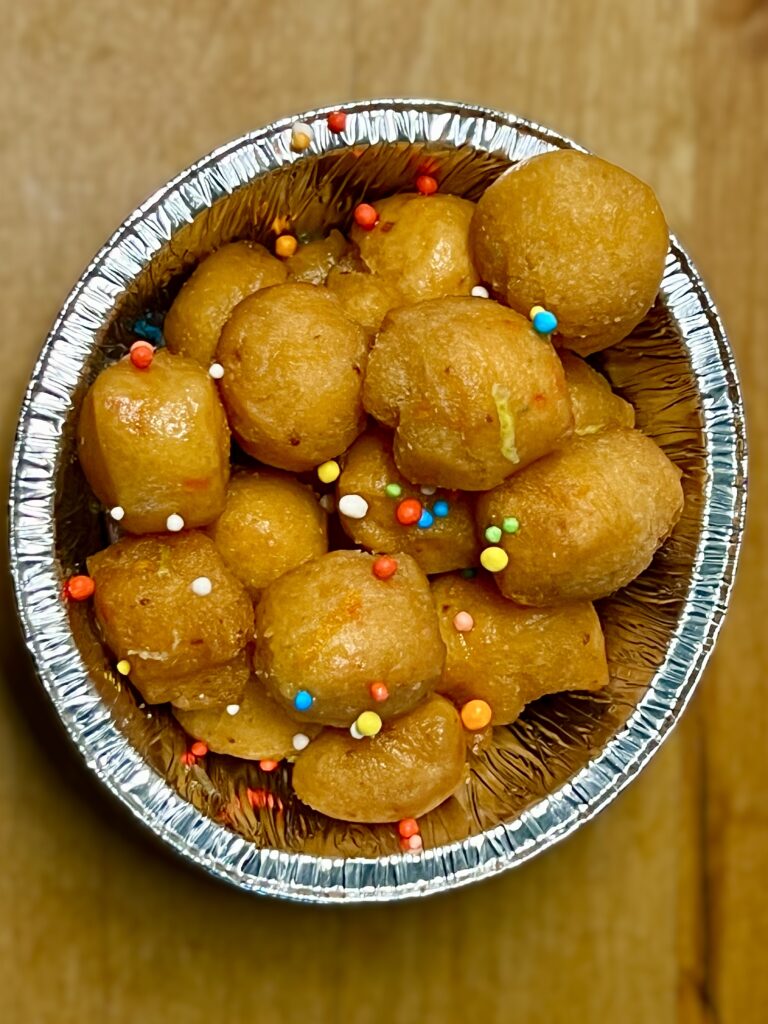
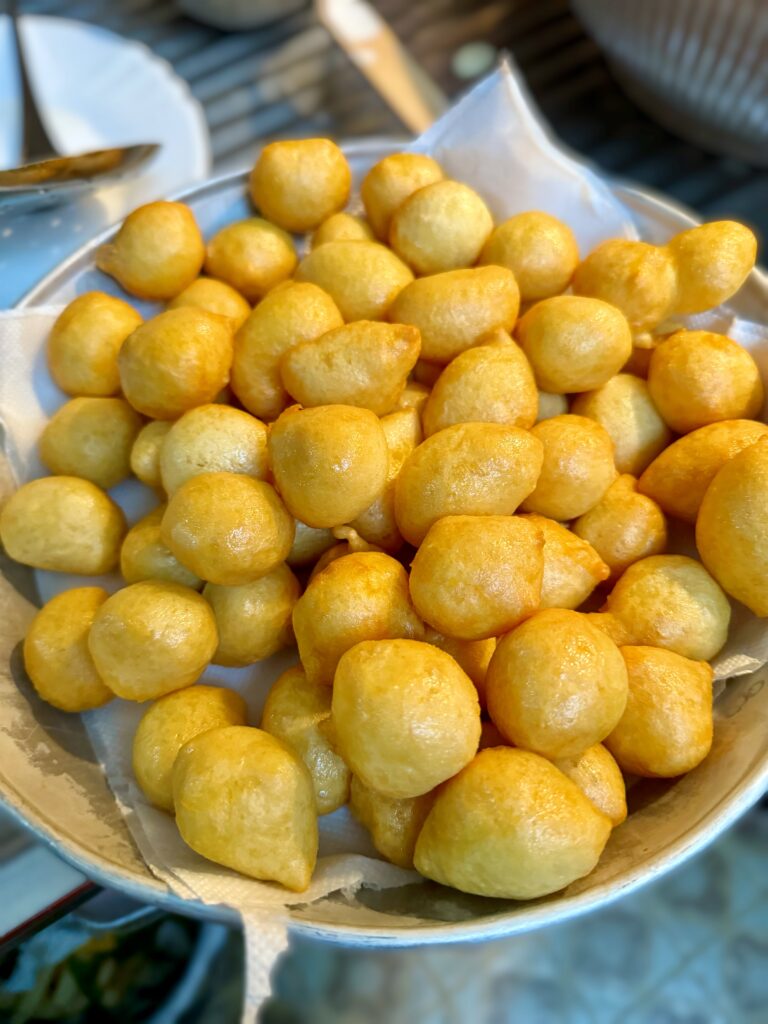
Festival del Cinema Europeo – Lecce (LE)
Held from 9 to 16 November 2024 at the Multisala Massimo, this film festival celebrates its 25th edition with screenings of European films in their original languages. The event includes retrospectives, awards such as the Golden Olive Tree, and guest appearances by leading directors—offering a major platform for European cinema in southern Italy.
Bacco nelle Gnostre – Noci (BA)
From 9 to 10 November 2024, Noci’s historic courtyards (gnostre) come alive with the scent of roasting chestnuts and tastings of vino novello. This two-day festival includes local cheeses, cured meats, and music performances. Now in its 21st edition, it remains one of Puglia’s most beloved autumn food and wine events.
Festa di San Martino – Martina Franca (TA)
Celebrated on 11 November, this autumn festival is deeply tied to the tradition of tasting vino novello, the year’s young wine. The town comes alive with food and wine tastings, roasted chestnuts, and open cellar tours. It’s a heartfelt tribute to rural hospitality and the bounty of the season.
La Fiera di San Martino – Taviano (LE)
Celebrated on 11 November, this fair blends religious and peasant traditions. San Martino, known for sharing his cloak with a beggar, is honoured with the tasting of vino novello (new wine), roasted chestnuts, and festive lunches. In Taviano, the event features lights, live music, street food, and market stalls showcasing local produce and crafts.
Novello sotto il Castello – Conversano (BA)
From 15 to 17 November 2024, Conversano’s medieval castle hosts this wine and food festival celebrating vino novello. The 14th edition features tastings from local wineries, traditional dishes, olive oil, cheeses, and live music. The event is organised by local cultural groups and marks a festive moment in the town’s calendar.
Festa dell’Olio Nuovo – Bitonto (BA)
Usually held in mid-November, Bitonto—often called the “city of oil”—celebrates the arrival of freshly pressed extra virgin olive oil. Events include tastings, guided visits to olive presses, food markets, and cooking demonstrations. A second round of festivities typically follows later in the month as more mills complete their pressing.
Festa di Santa Cecilia – Nardò (LE)
Held on 22 November in honour of Saint Cecilia, patron saint of music. The celebration features concerts, brass band performances, and choir recitals across the town’s churches and piazzas, showcasing local musical traditions.
Sagra della Mandorla – Turi (BA)
In the third week of November, this festival highlights the almond, a prized local crop. Events include tastings of almond-based sweets, torroni, and liqueurs, as well as cookery workshops and artisanal stalls.
December Will Be Magic Again

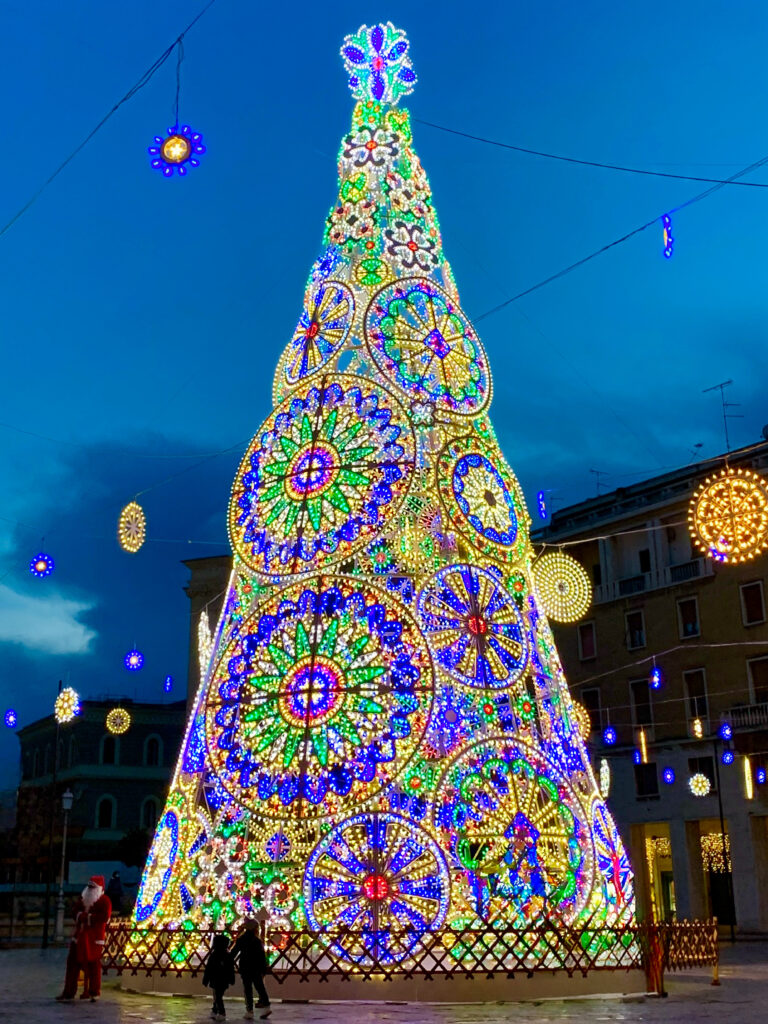
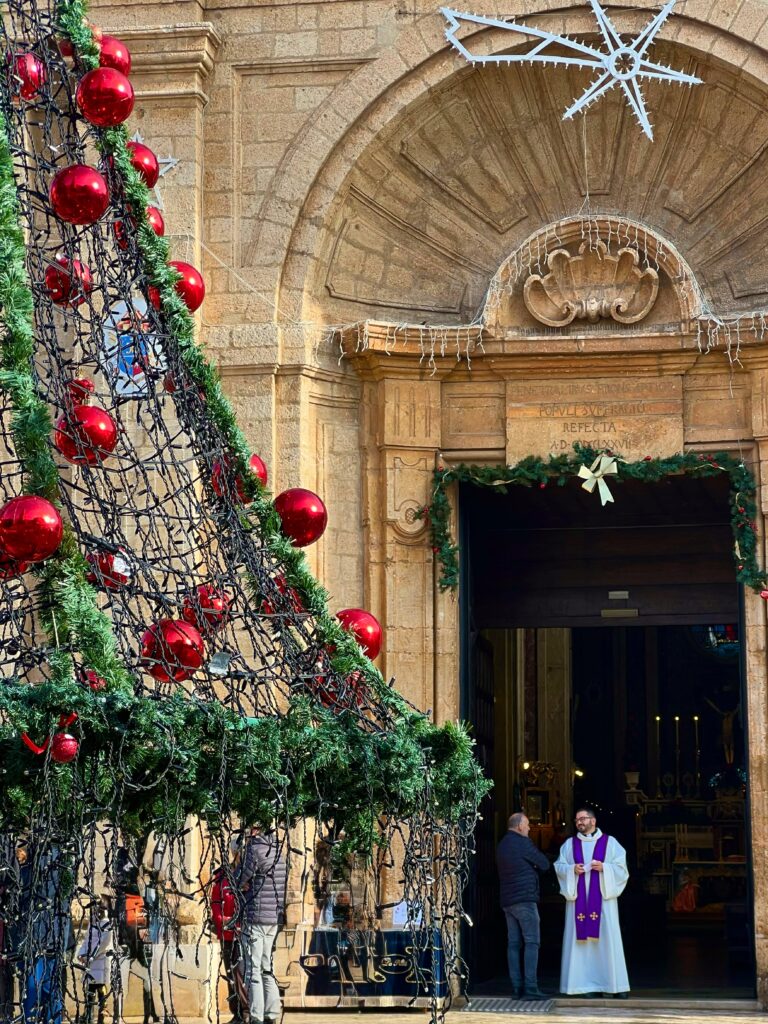
Mercatini di Natale – Lecce (LE)
Throughout December, Lecce’s Christmas markets fill the historic centre with festive cheer. Stalls offer handmade crafts, seasonal delicacies, and traditional decorations, all framed by baroque architecture glowing under twinkling lights.
Festa di San Nicola – Bari (BA)
Celebrated on 6 December, this event marks the beginning of the Christmas season in Bari. It starts with a dawn mass in the Basilica di San Nicola and a torchlit procession through the historic centre. Traditional hot chocolate and local pastries are served in the old town. In the evening, the Christmas tree in Piazza del Ferrarese is illuminated with fireworks, and festive markets offering handmade crafts and regional delicacies open across the city.
Festa dell’Immacolata Concezione – Foggia (FG)
Held on 8 December, this religious celebration in honour of the Immaculate Conception features solemn Masses, processions and street illuminations, marking the official beginning of the Christmas season in many Puglian towns.
Sagra del Torrone e del Croccantino – San Marco in Lamis (FG)
This mid-December festival pays homage to traditional Christmas sweets like torrone (nougat) and croccantino (crunchy almond brittle). Visitors can watch live demonstrations, enjoy tastings, and explore artisanal stalls showcasing these seasonal treats.
Festa di Santa Lucia – Otranto (LE)
Celebrated on 13 December, this feast includes a candlelit procession through the old town, honouring Saint Lucy. Boiled wheat (grano cotto) is distributed as a symbol of fertility and abundance. The event also features traditional music and food stands.
Presepe Vivente – Pece (LE)
From 24 December to 6 January, the village of Pece hosts one of Puglia’s most atmospheric living nativity scenes. Locals don historical costumes to recreate biblical scenes in a natural setting, transforming the town into a faithful recreation of Bethlehem.
Concerto di Natale – Trani (BT)
Around Christmas Day, Trani Cathedral hosts a sacred music concert featuring orchestral and choral performances. The majestic setting and candlelit interior create a solemn and moving atmosphere.
Carnevale di Putignano – Putignano (BA)
The Carnevale di Putignano begins on 26 December with the Festa delle Propaggini, where performers in peasant costume recite satirical verses in dialect. It is one of the oldest carnivals in Europe, dating back to 1394, and continues into February. The festivities feature allegorical papier-mâché floats, masked parades, and the carnival’s iconic figure, Farinella. The event blends sacred tradition with irreverent satire and celebration.
Christmas Markets and Light Displays – Various Towns
Throughout December, towns and cities across Puglia light up with festive illuminations and Christmas markets. Ostuni hosts markets from 8 December to 6 January, while Alberobello’s trulli are adorned with lights and projections. Other towns such as Locorotondo, Lecce, Bari, and Brindisi offer artisan markets, concerts, and nativity scenes that create a magical holiday atmosphere steeped in tradition and regional charm.
Presepe Vivente di Tricase – Tricase (LE)
Considered one of Italy’s most impressive living nativity scenes, the Presepe Vivente of Tricase is set on the hillside of Monte Orco. Its 43rd edition was held on various evenings from 25 December to 6 January. Costumed volunteers recreate a full Bethlehem village with artisans, shepherds, and traditional scenes. Thousands of visitors walk through the living tableau, which combines religious devotion, historical fidelity, and local culture.
Capodanno in Piazza – Bari (BA)
On 31 December, Bari’s main square becomes the setting for a huge New Year’s Eve celebration, with live music, DJs and fireworks. The event attracts thousands of revellers and offers a festive, communal way to ring in the new year.
Pilgrimage and Sacred Landscapes in Puglia
In Puglia, pilgrimage is a journey for many. A footstep laid down on limestone and clay, through olive groves and mountain passes, on roads etched by centuries of faith, devotion, and resilience. From the holy heights of Monte Sant’Angelo to the hidden hilltop hamlets of Daunia, our region offers some of Italy’s most powerful and moving sacred itineraries — where the landscape itself becomes a shrine, and the festivals that animate it are living rituals of memory.

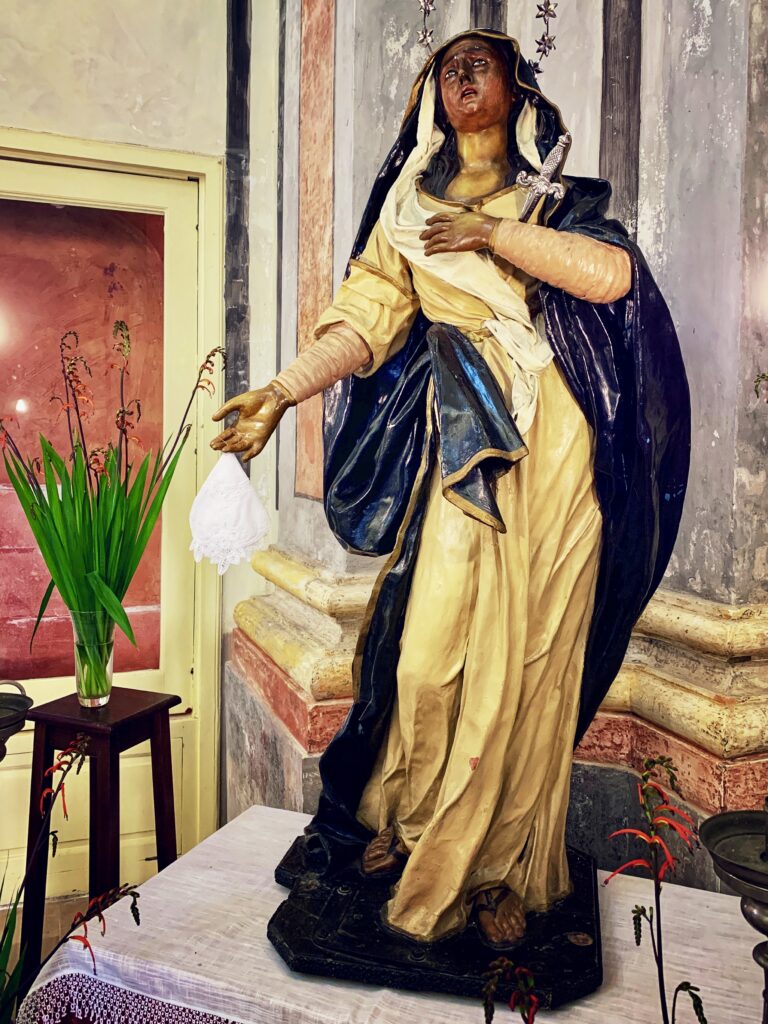
Walking the Sacred Mountain: The Gargano Routes
The Gargano is more than a landscape — it is a living map of devotion. Its sacred sites and seasonal rituals form a deep-rooted spiritual geography that has shaped Puglia as a place of saints, shepherds and seekers.
From Vico del Gargano, where Saint Valentine is honoured with citrus-fragrant blessings, to Incoronata, where the Cavalcata degli Angeli sees horses and children dressed as angels circle the sanctuary, faith here is embodied — in footsteps, in gesture, in celebration.
At its heart rises the Sacred Mountain of the Gargano — Italy’s oldest Christian pilgrimage destination, even predating Assisi and Rome. Its paths are still walked, its stones still prayed upon. Here, pilgrimage is not only tradition but transformation: a quiet journey through landscape and soul.
Pietramontecorvino – Sant’Alberto and the Living Forest of Devotion
Tucked into the Daunian Apennines, Pietramontecorvino is a quiet hilltown where sacred tradition and rural life intertwine. A recognised Borghi più belli d’Italia and holder of the Bandiera Arancione for sustainable tourism, it offers a deeply rooted pilgrimage experience away from the crowds.
The town’s defining ritual unfolds each 16–17 May during the Festa di Sant’Alberto. The highlight is a procession to Monte Corvino — the ruins of a Byzantine-era bishopric — where pilgrims carry not only the saint’s statue but towering palij: 20-metre-high poles adorned with ribbons, handkerchiefs and family offerings, prepared weeks in advance from trees felled in a nearby communal forest.
These living totems, carried with song and prayer, create a moving forest across the countryside — a powerful symbol of faith and belonging. Today, women and children carry their own palij, transforming the once all-male rite into a celebration of shared identity across generations.
Back in the village, the spiritual gives way to celebration. Tables overflow with sfringl’ (fried pizza), nogghjie (rustic pork sausages) and sugar-dusted cumplment — flavours rich in memory and meaning. In Pietramontecorvino, pilgrimage is a return: to land, to tradition, to community.
Monte Sant’Angelo – The Archangel’s Sanctuary
High in the Gargano mountains, Monte Sant’Angelo is one of Europe’s oldest and most revered pilgrimage sites. At its heart lies the Sanctuary of Saint Michael the Archangel, a cave shrine that has drawn worshippers since 490 AD. Recognised by UNESCO, the sanctuary is still accessed by a dramatic staircase carved into the rock.
The town is rich in sacred heritage, from the medieval Swabian-Aragonese castle to the frescoed church of Santa Maria Maggiore and the remote Abbey of Pulsano. It also borders the Foresta Umbra, a primeval beech forest and UNESCO World Heritage Site.
Each year on 29 September, the Feast of Saint Michael fills the streets with pilgrims, prayers and tradition. The Procession of the Sacred Sword — a symbol of the Archangel’s protection — winds through candlelit alleys, accompanied by music, food stalls and re-enactments. Local specialities like scaldatelli, ostie piene, and mountain olive oil ground the celebration in the tastes of the land, where the spiritual and the earthly have long gone hand in hand.
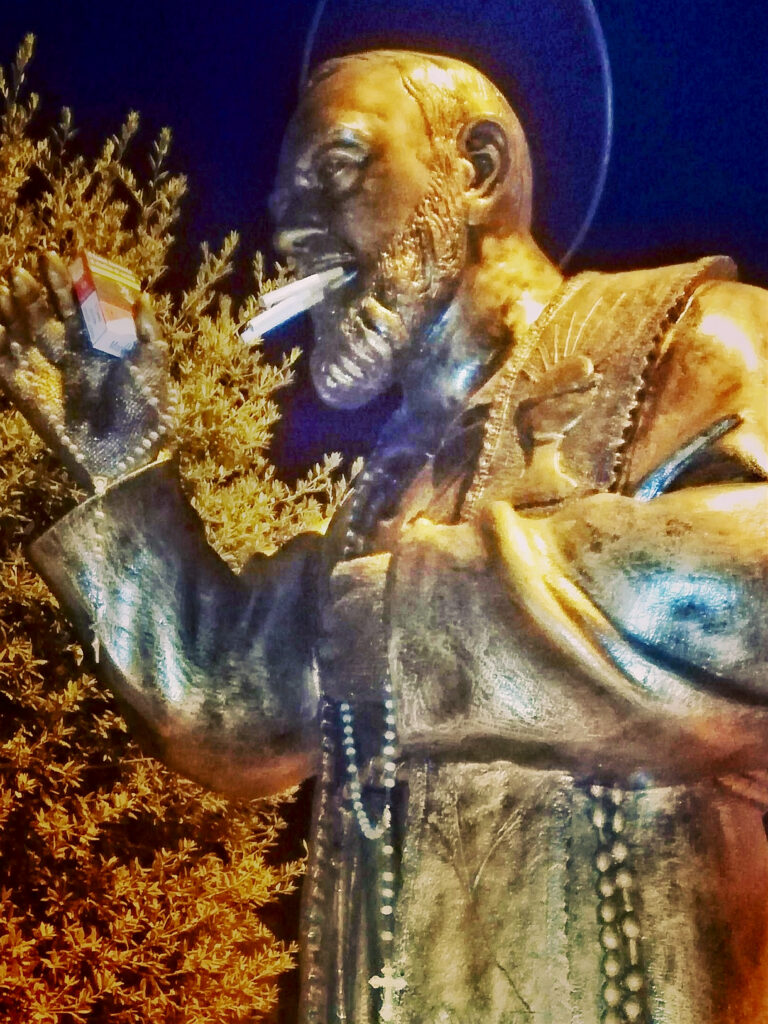
The Path of the Madonna: Saintly Processions and Devotion from Bari to Capurso
If fire is the language of Puglia’s winter festivals, and light animates its summer feasts, then the language of pilgrimage and procession is what binds the region’s spiritual calendar together. Along the Adriatic coast and into the agricultural plains south of Bari, a series of epic religious celebrations unfold between May and September — centred on icons of the Virgin Mary and patron saints, many of whom are shared, disputed, or celebrated with pageantry across generations.
These aren’t simple processions. They’re ritual journeys — stories told in steps, in lace-trimmed altars carried on shoulders, in orchestras echoing down alleyways, and in communities remade, if only for a few days, in devotion.
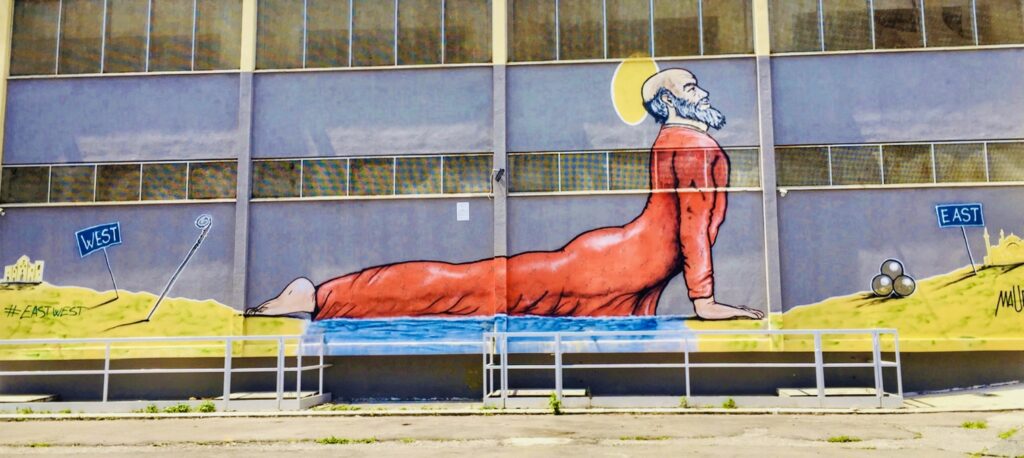
Bari – The Sea and the Saint
The city of Bari, capital of the region and gateway to the East, is most closely associated with San Nicola (Saint Nicholas) — the saint who inspired Santa Claus, yes, but whose relics lie in the Basilica di San Nicola, attracting Orthodox pilgrims from across Eastern Europe and Russia.
From 7 May, Bari celebrates its patron with a spectacular three-day festival that includes a historical re-enactment, a maritime procession, and a host of cultural and religious events. The statue of San Nicola is taken aboard a boat in a symbolic retracing of his arrival from Myra, accompanied by a flotilla and fireworks over the sea. It’s one of southern Italy’s most vivid celebrations of intercultural faith, with Byzantine chants and Latin hymns ringing out together.
But Bari’s other, perhaps more intimate, festival is the Feast of Maria Santissima del Rosario, celebrated in September. In the Madonnella district, where 19th-century working-class families once built their homes around a wayside shrine, devotion to the Virgin takes on a more neighbourhood feel. Here, homes are decorated with altars, balconies festooned with white linens and flowers, and streets come alive with a quiet but sincere reverence.
It’s in these smaller feasts that the everyday holiness of Puglia is felt most — less theatrical, more tender, the Madonna not just as protector of cities, but as mother of streets and windows.
Bitonto – The Palio of the Madonna
Inland from Bari, the town of Bitonto, famous for its Romanesque cathedral and vast olive groves, honours the Madonna of the Immacolata in a singular and historic way.
During the second Sunday of May, the town stages the Palio della Madonna, a chivalric competition whose origins date back to the 17th century. The event symbolically re-enacts the miraculous saving of Bitonto from a plague, attributed to the Virgin Mary, and it includes a parade of costumed participants representing the city’s ancient “seggé” or districts.
The central event is a horse race, run with great passion, alongside performances by flag-throwers and musicians, all set beneath grand luminarie lighting displays. The Virgin’s statue is carried in solemn procession, while the streets echo with both sacred chant and patriotic pageantry. It’s a celebration that blends civic pride and religious reverence, echoing the town’s long role as a cultural and agricultural powerhouse of the region.
Capurso – The Madonna del Pozzo
Further south lies Capurso, a town whose identity is almost entirely entwined with its beloved Madonna del Pozzo (Our Lady of the Well) — one of Puglia’s most revered Marian devotions. According to tradition, in 1705, a priest discovered a sacred image of the Virgin at the bottom of a well, sparking a series of miraculous healings and leading to the construction of the Santuario della Madonna del Pozzo, a sanctuary now known throughout the region.
Each August, Capurso becomes the focal point of a days-long pilgrimage known as the Cammino della Madonna. Pilgrims travel on foot from surrounding towns and rural communities, many walking all night to arrive at dawn. Among the most famous are those from Cellamare, whose journey includes hymns, silence, and a break for rustic bread and roasted peppers — a meal as symbolic as it is nourishing.
Once in Capurso, the celebration swells. The statue of the Madonna is paraded through streets bursting with banners, confetti, and floral arches. Families gather on balconies with candles, and the sanctuary remains open all night for vigils and prayers.
The festival ends with a spectacular “fire race” — a competition of local pyrotechnic teams who light up the night with artful explosions, and with the sharing of dolci tradizionali, including zeppole, cartellate, and susumelle — sweets scented with citrus, honey and cloves, echoing the gifts once left at the well.
Walking With Saints | Devotion and Ritual in Grumo Appula, Terlizzi and Turi
Puglia’s summer isn’t only lit by fireworks and luminarie — it marches to the beat of saints’ processions, where civic devotion, agricultural identity, and sacred spectacle come together in celebrations that date back centuries. In the small towns of the Terra di Bari, faith is performed with flair: saints are paraded with full orchestras, entire neighbourhoods compete to build the most extravagant altars, and human pyramids are formed in honour of protectors who once saved towns from plague, drought, or fire.
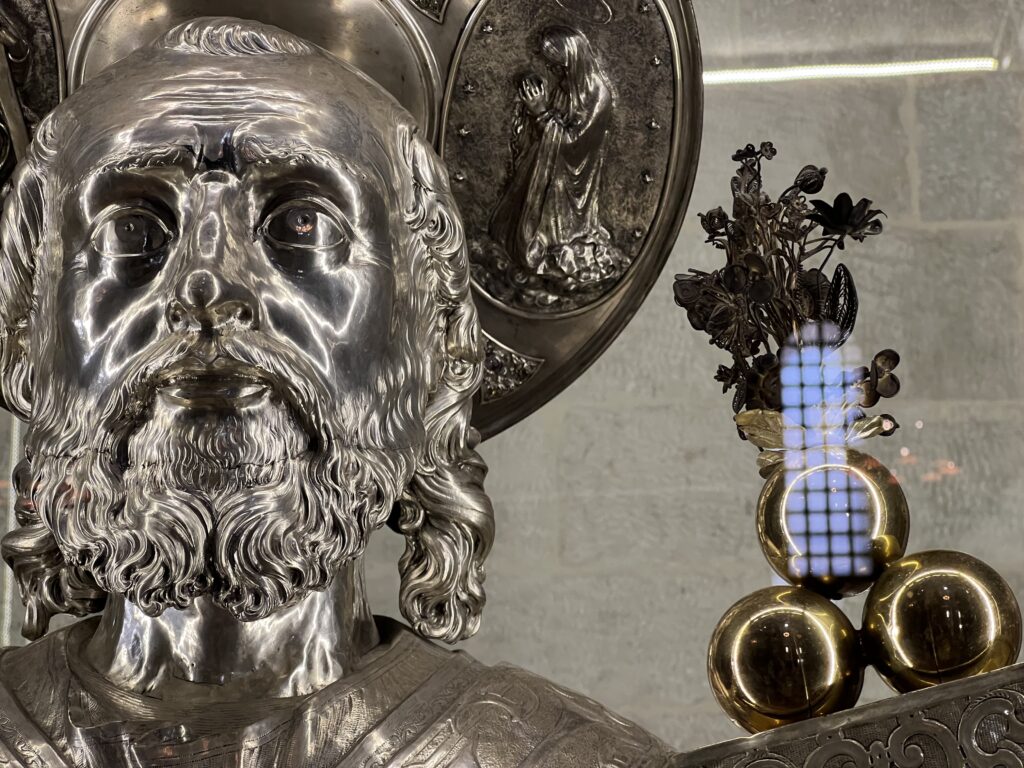
Grumo Appula – The Santi Medici and the Ritual of Return
In Grumo Appula, located just inland from Bari, the summer festival calendar culminates in late September or early October with the Feast of the Santi Medici — Cosma and Damiano, two early Christian doctors and miracle workers beloved throughout southern Italy.
But here, the tradition is uniquely reversed.
Instead of celebrating the arrival of the saints, the people of Grumo commemorate their departure. Following the example of nearby Bitonto (whose sanctuary was long a centre of Santi Medici worship), Grumo’s community re-enacts the return of the saints’ statues to their chapel, in a powerful reversal that symbolises the end of the season, the closing of a spiritual circle, and the carrying of blessings back home.
As the statues are returned, they’re not merely walked — they’re carried in a slow, elaborate dance, swaying to the rhythm of brass bands and accompanied by a sea of pilgrims waving white handkerchiefs in farewell. The procession winds past homes decorated with lights and votive banners, while spectators shower the saints with confetti, rose petals, and promises.
Though smaller in scale than some of Puglia’s grander festivals, the intensity of emotion in Grumo Appula is striking. For many, this isn’t a show — it’s a moment to touch something sacred, something inherited, something felt in the bones.
Terlizzi – The Triumph of the Crocifisso
In the larger town of Terlizzi, home to one of the region’s most monumental bell towers, the streets burst into full theatrical devotion during the Festa Maggiore, dedicated to the Crocifisso di Colonna.
Held each early August, the celebration recalls the moment in 1851 when a miraculous image of the crucifix — long venerated in the countryside — was brought triumphantly into the town after a severe drought. The icon is now carried in a massive wooden “triumph” cart, about 22 metres tall, towed by eight robust mules and flanked by thousands of spectators.
The cart’s progress is slow, solemn, and symbolic. It creaks through the streets, looming above rooftops, passing under arches of luminarie and festoons of white and gold. It’s both a religious relic and a feat of community engineering, prepared in secret and revealed in splendour.
The entire town becomes involved. Days before, children and adults help to prepare the pali (poles) and build flower-covered structures. Marching bands rehearse in the piazza. Local bakeries churn out sgagliozze (fried polenta squares)and cartellate, while visitors descend from nearby cities to take part.
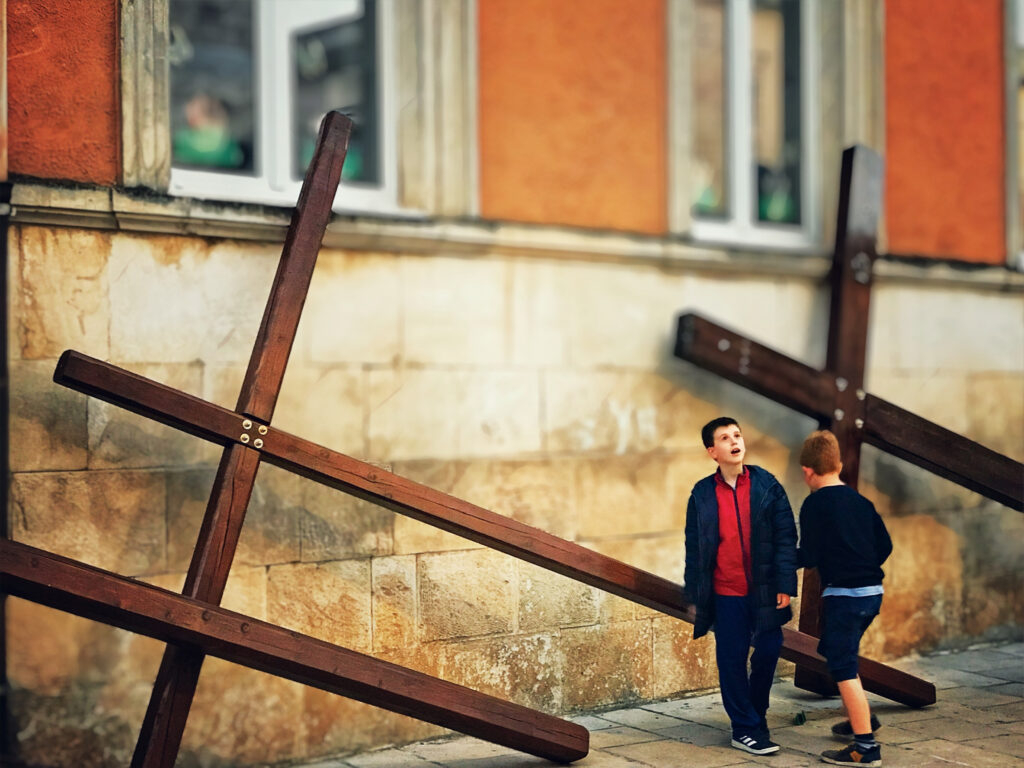
Turi and the Festa di Sant’Oronzo
Set amid cherry orchards and rolling farmland, the town of Turi is best known for two things: its prized “ferrovia” cherries — among the finest in Italy — and its deeply rooted devotion to Sant’Oronzo, the town’s patron saint.
Each year, on the last Sunday of August, Turi celebrates the Festa di Sant’Oronzo with a blend of solemnity, spectacle, and enduring rural tradition. At dawn, pilgrims make their way on foot to the grotto of the saint, a natural cave sanctuary, where a votive Mass is held in the early light.
The day continues with the Processione di Gala, a ceremonial parade through the streets of the town. Dignitaries, historic confraternities, civic and military authorities, and colourfully dressed flag-throwers accompany the procession. But the centrepiece comes in the evening, when the colossal Carro Trionfale makes its entrance.
This towering, ornate float — over 14 metres tall and 8 metres long, made entirely of intricately carved wood — carries the bust of Sant’Oronzo through the packed streets. It is pulled by six mules, flanked by cheering crowds, and accompanied by bands and bursts of fireworks. A powerful symbol of faith and community, the float is a testament to the skill of local master woodworkers, who preserve the tradition with pride and artistry.
The arrival of the float in the main square is met with an explosion of petals, pyrotechnics, and music, creating an atmosphere of exaltation and joy. It is a moment that fuses religious reverence with a strong sense of local identity.
As always in Puglia, the celebration is incomplete without food: street stalls offer fresh focaccia, grilled meats, stuffed olives, and cherry-based sweets, linking the festival to the land that sustains it.
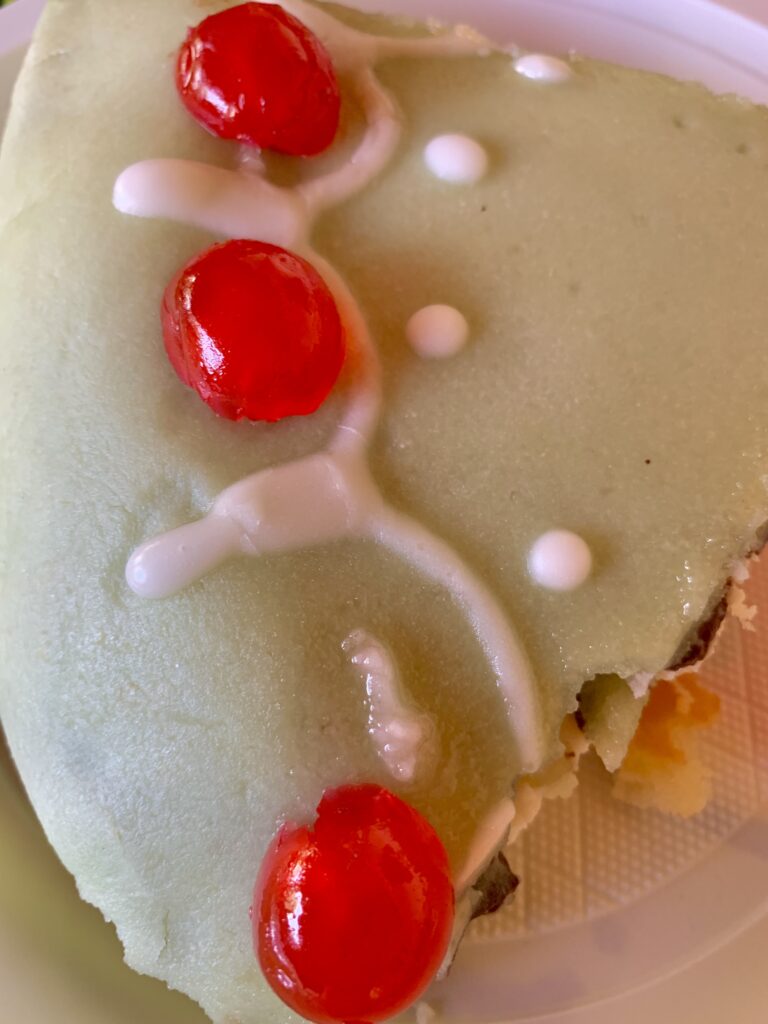
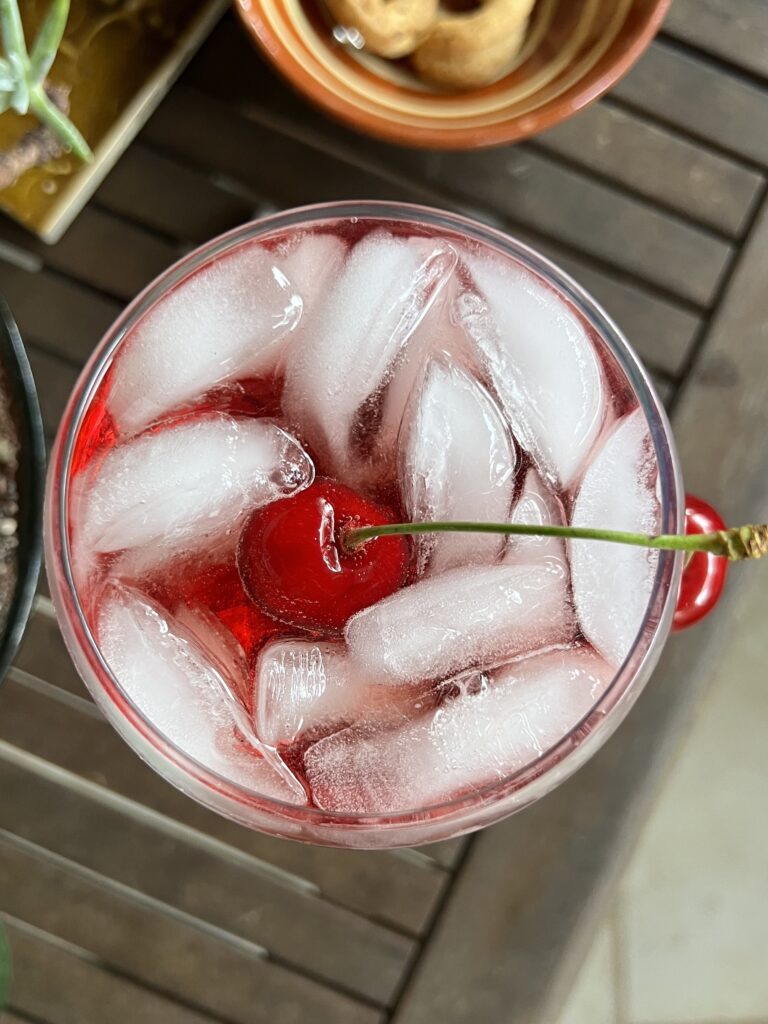
Rituals on Water: Puglia’s Sea Processions
Bound by two seas, Puglia lives in constant dialogue with the waves. Nowhere is this connection more vivid than in the region’s maritime festivals, where saints are launched from harbours, boats bloom with flowers and flags, and coastal towns pause to honour their protectors at sea.
These are not just spectacles, but centuries-old rituals shaped by fishing, migration, and the ever-present tension between danger and deliverance. The sea becomes both stage and sanctuary — where faith sails on salt air.
In the lagoon town of Lesina, within the Gargano National Park, the Festa di San Primiano (last Sunday in May) sees the saint ferried across the lake on a traditional sandalo. The waters are blessed from its centre, in a prayer for protection and abundance for the fishing community.
Further south in Polignano a Mare, the Festa di San Vito takes place dramatically along the cliffs. Boats carry the saint’s image along the coast, flanked by crashing waves and candlelight from the shore. The devotion continues with local seafood and the town’s signature caffè speciale — espresso laced with lemon, amaretto and cream.
In Monopoli, the sea delivers the Madonna della Madia not once, but three times, recalling a legend of divine timing and persistence. Her arrival by boat, followed by a grand land procession, is one of the city’s most powerful expressions of collective faith.
Brindisi honours its patron saints with the Palio dell’Arca, a historic boat race recalling the recovery of Saint Theodore’s relics from the sea. Local schifarieddi dart across the harbour in a blend of sport and reverence.
These sagre a mare — sea feasts — express a unique, enduring relationship with the waters that shape Puglia’s coasts. Whether in silence or celebration, the sea here remains sacred: a place of prayer, memory, and belonging.
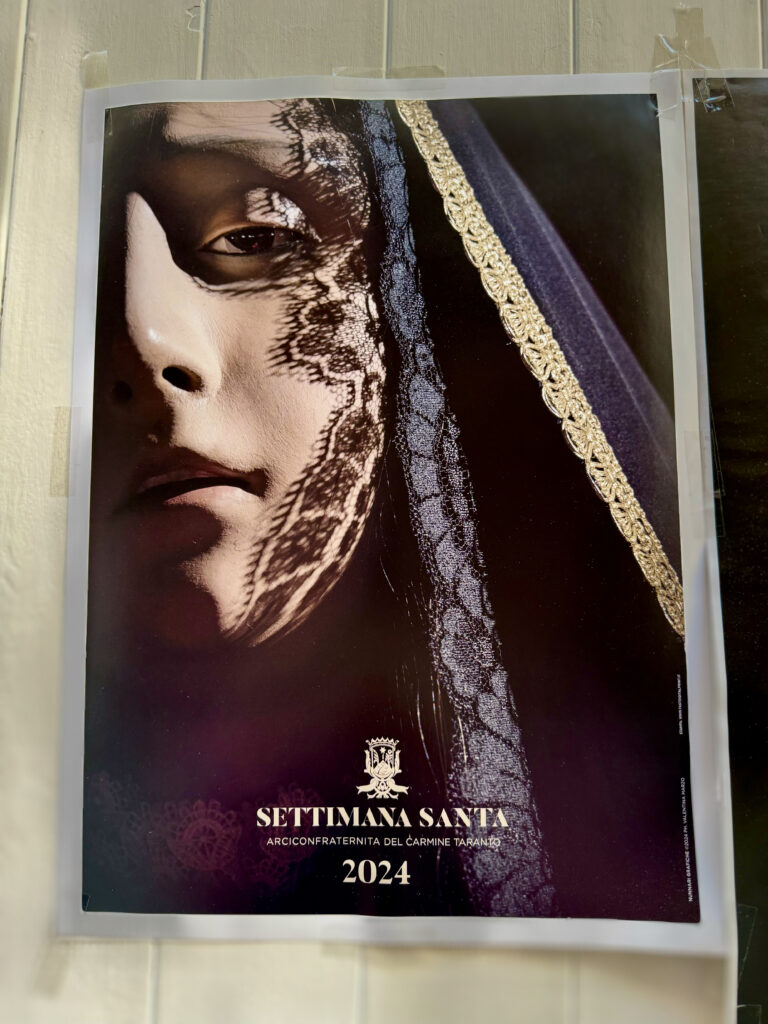
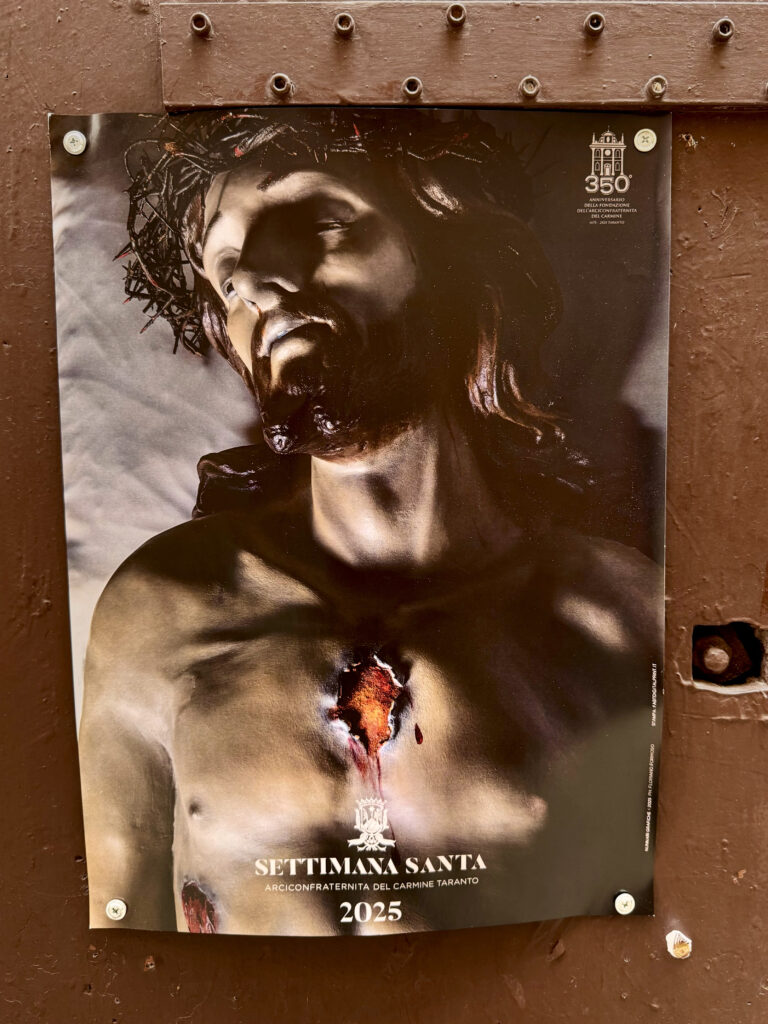
Sea and Spirit: Puglia’s Coastal Devotions
Taranto – Madonna del Carmine and the Floating Procession
In mid-July, Taranto reaches its spiritual height with the Festa della Madonna del Carmine. It begins at the Chiesa del Carmine with solemn liturgies and the rare unveiling of a miraculous wooden statue. The climax comes as the statue is placed on a small boat and carried across the Mar Grande, accompanied by a flotilla of naval and civilian vessels. As dusk falls and candlelight flickers on the waves, the Madonna appears to float over the water, her golden crown glowing in the last light.
Once ashore, the procession continues through the Borgo Antico with banners, incense, and music. The evening ends as Tarantini always do — with food. Dishes like cozze arraganate (stuffed mussels) and fritture di paranza (mixed fried fish) bring the celebration back to sea and table.
Molfetta – Madonna dei Martiri and the Flotilla of Devotion
Each September, Molfetta honours the Madonna dei Martiri with one of Puglia’s most cherished sea processions. Local fishermen carry a flower-decked statue of the Madonna aboard a trawler, which leads a flotilla of boats out of the harbour. Sirens sound, bells ring, and rose petals drift from balconies above — transforming the Adriatic into a sacred space.
After the sea procession, the Madonna is crowned and paraded through town. For Molfetta’s fishing families, she remains the guardian of those who brave the open water.
Gallipoli – Santa Cristina and the Greased Pole of Glory
In July, Gallipoli celebrates Santa Cristina, protector of seafarers and miracle-worker. Her statue is carried in a fishing boat across the harbour, followed by a festive flotilla and a city-wide celebration that blends ritual with revelry.
The highlight? The cuccagna al mare — a greased horizontal pole suspended over the sea. Young men attempt to run across it and grab a flag at the tip, tumbling into the water to the crowd’s delight.
On shore, the feast continues with scapece (marinated fried fish) and cupeta (almond brittle), shared along the waterfront as music drifts into the summer night.
Polignano a Mare – The Madonna and the Cliffside Blessing
Polignano’s dramatic cliffs and turquoise waters provide an unforgettable setting for its annual sea procession. The Madonna is first carried through the town’s whitewashed streets, then taken down to the tiny port and placed on a boat. As she sails below the cliffs, the townspeople watch from rooftops and terraces, quiet in reverence.
Less elaborate than other coastal festivals, Polignano’s procession is contemplative and intimate — a moment of pause between rock and sea, when the soul of the city seems to bow before its most enduring symbol of grace.
Lesina – The Lake and the Blessing of the Waters
On the northern edge of the Gargano, Lesina’s Festa della Madonna di Costantinopoli takes place not on the open sea but across the glassy surface of Lake Lesina each early August.
The Madonna departs from the Santuario di Ripalta aboard a boat, followed by a flotilla of fishing skiffs that glide across the water at dawn. Rose petals are scattered, hymns are sung, and the stillness of the lake becomes a vessel for devotion.
At the heart of the ritual is the blessing of the lake itself — a prayer for the health of the waters and those who rely on them. Afterwards, the town gathers in gentle celebration, with seafood feasts, storytelling, and music echoing through its quiet lanes.
More Puglia | Find the best base for your vacation in Puglia.
More Puglia | Plan the perfect Puglia itinerary for your travel style.
